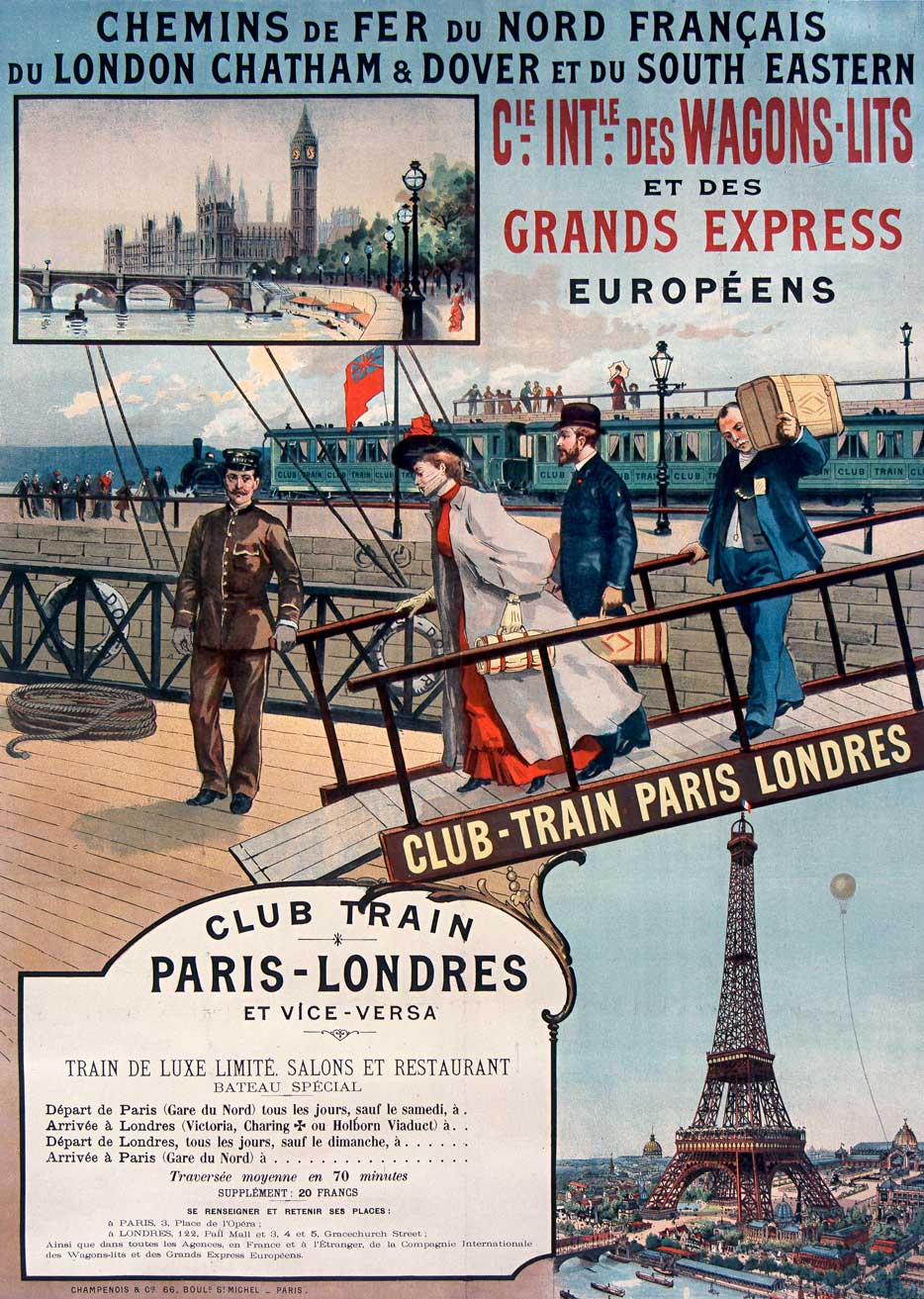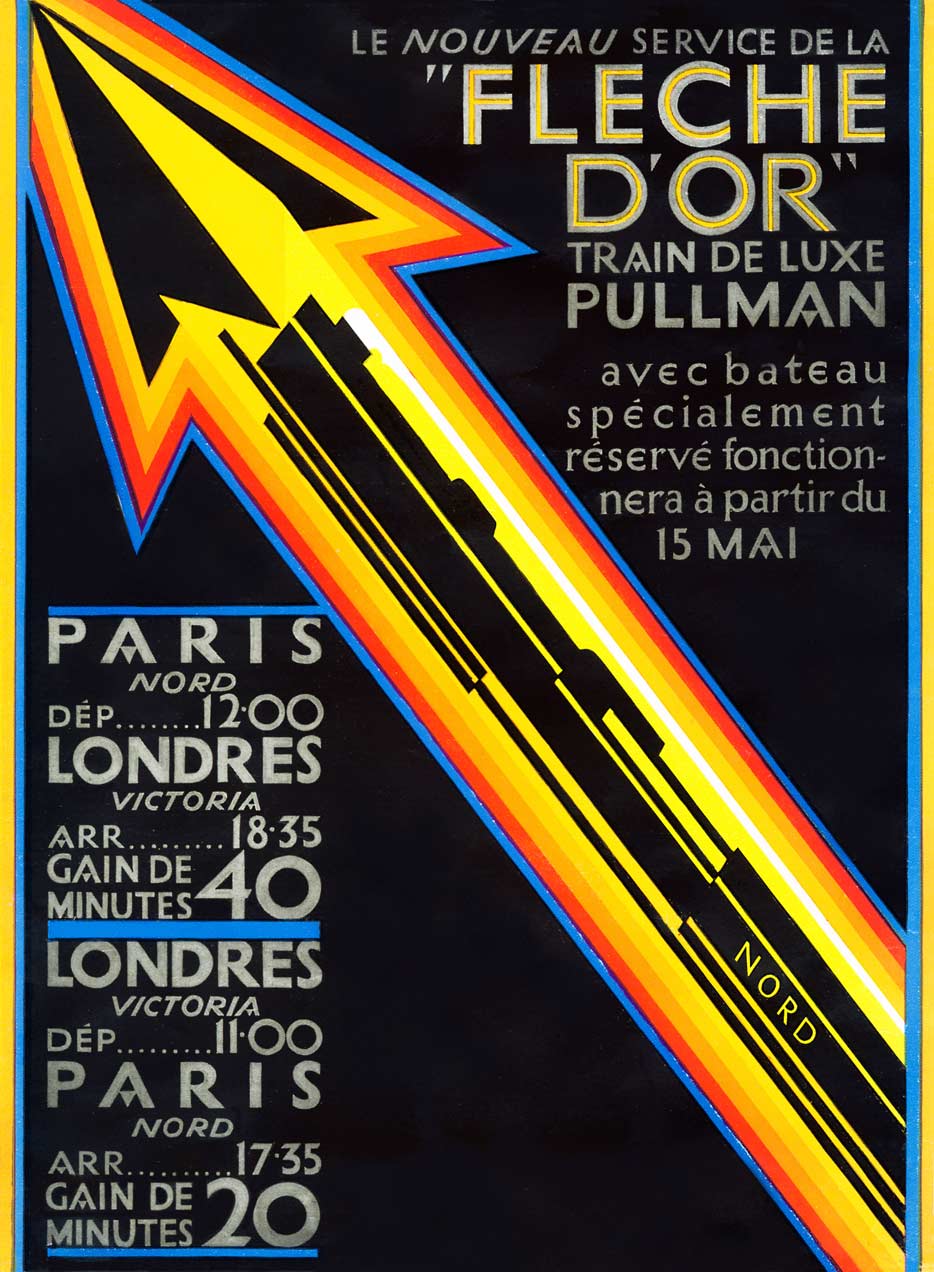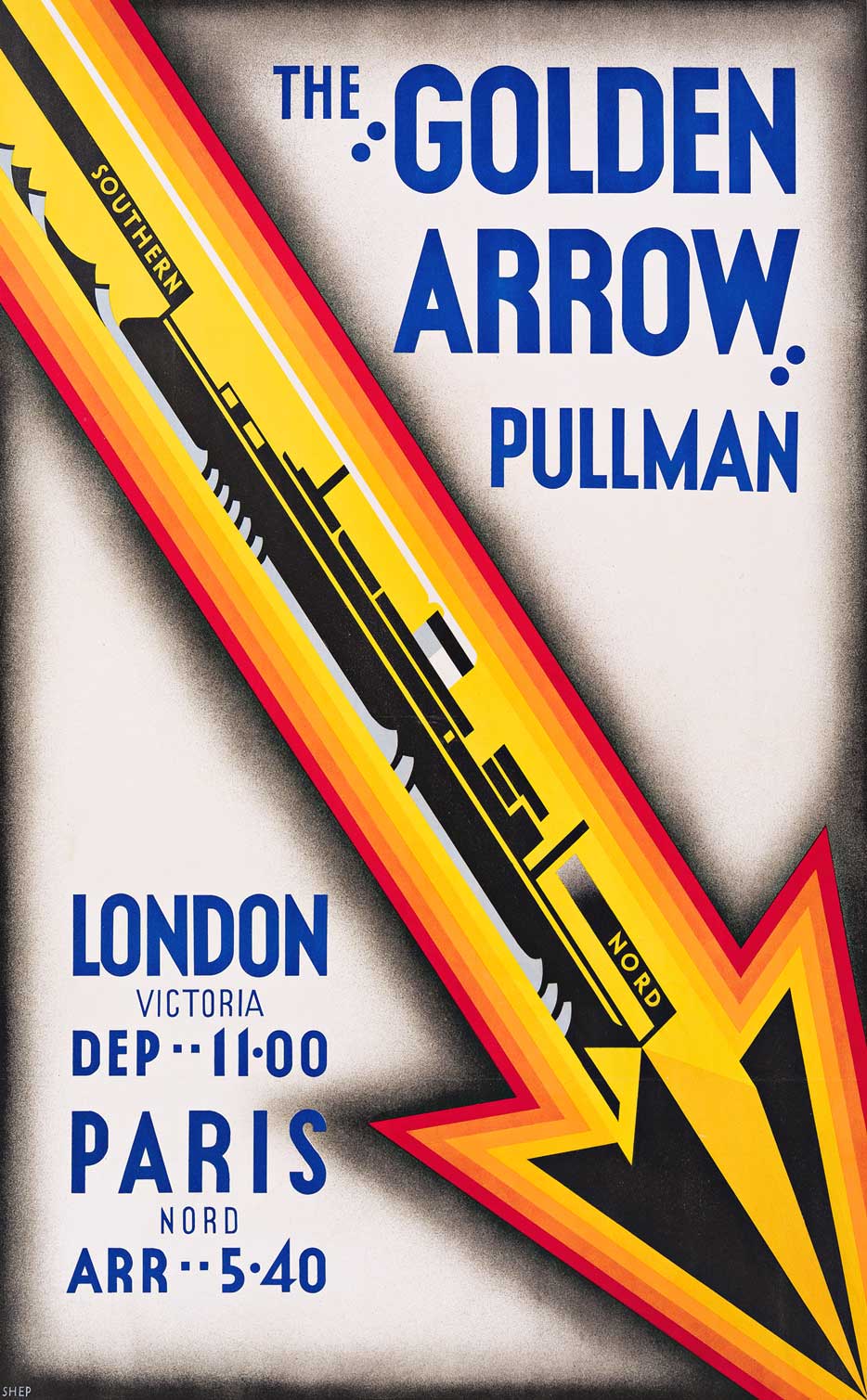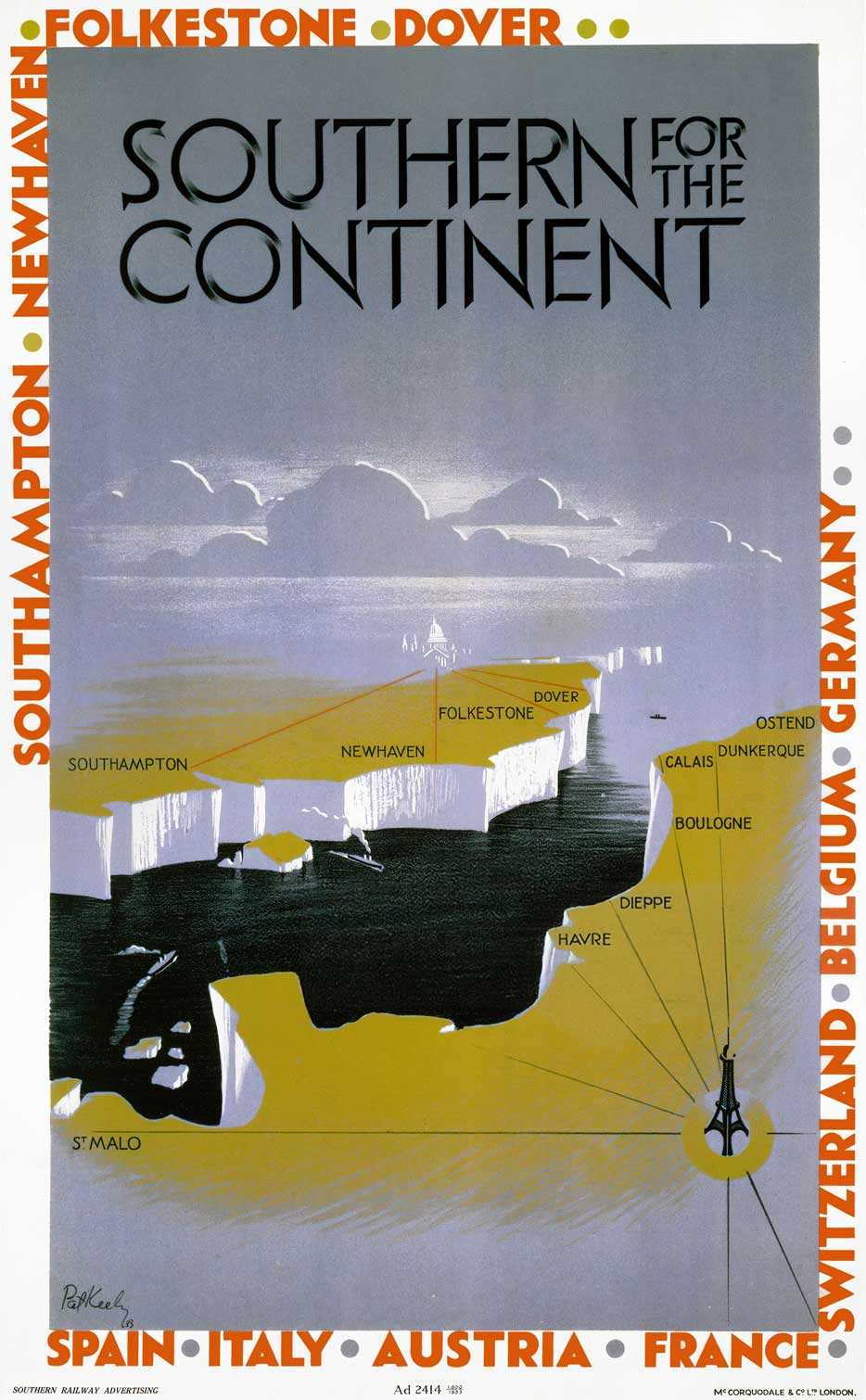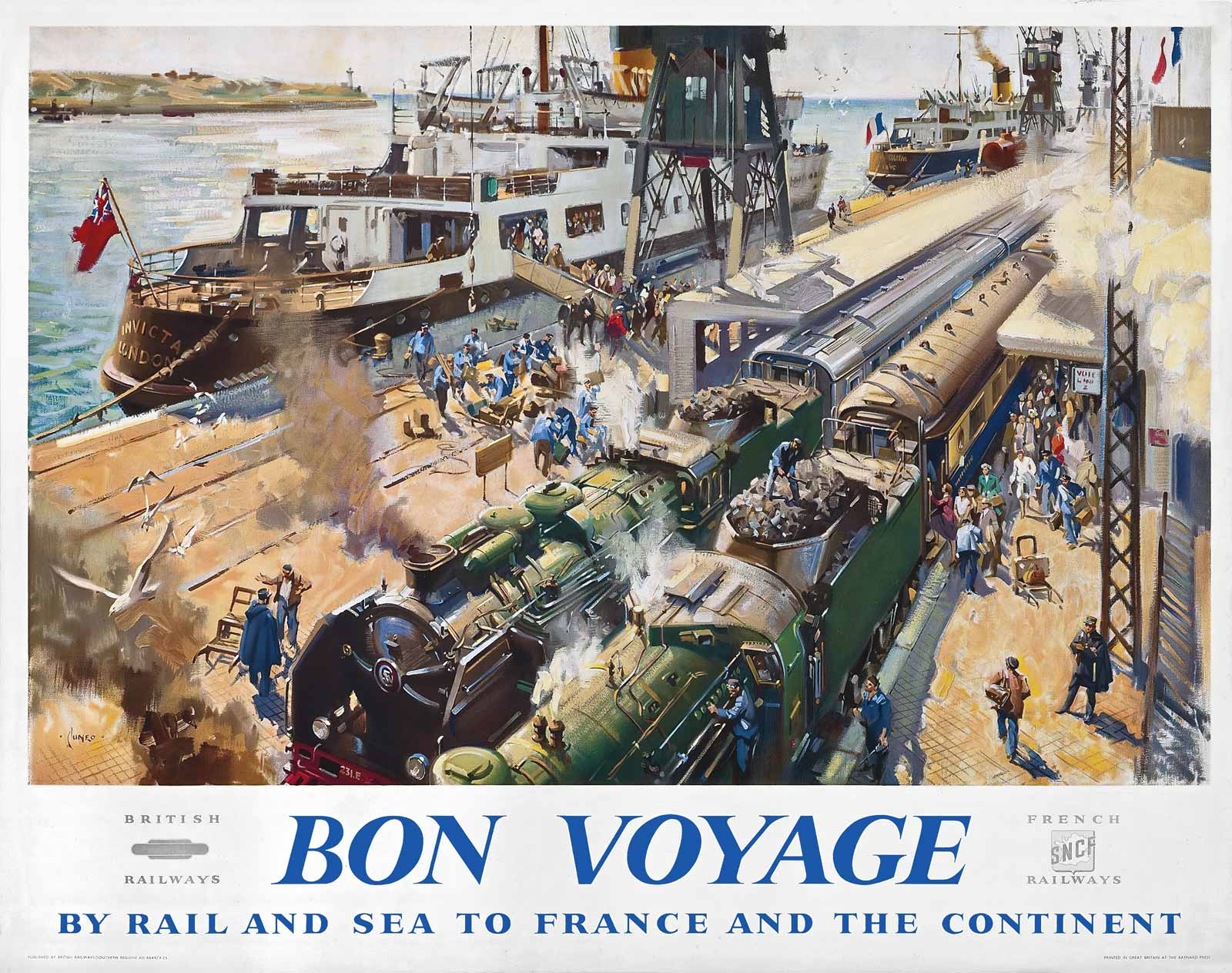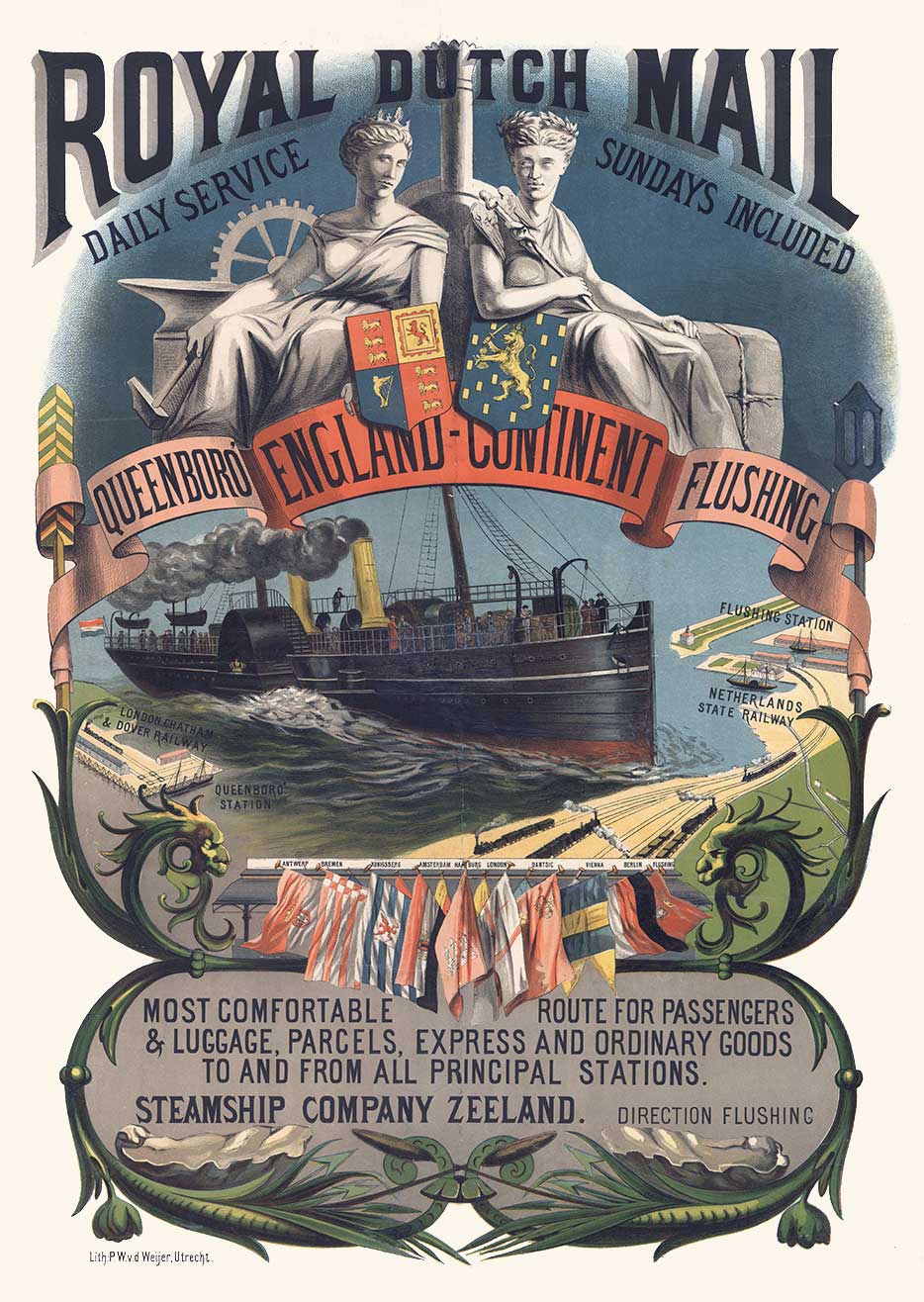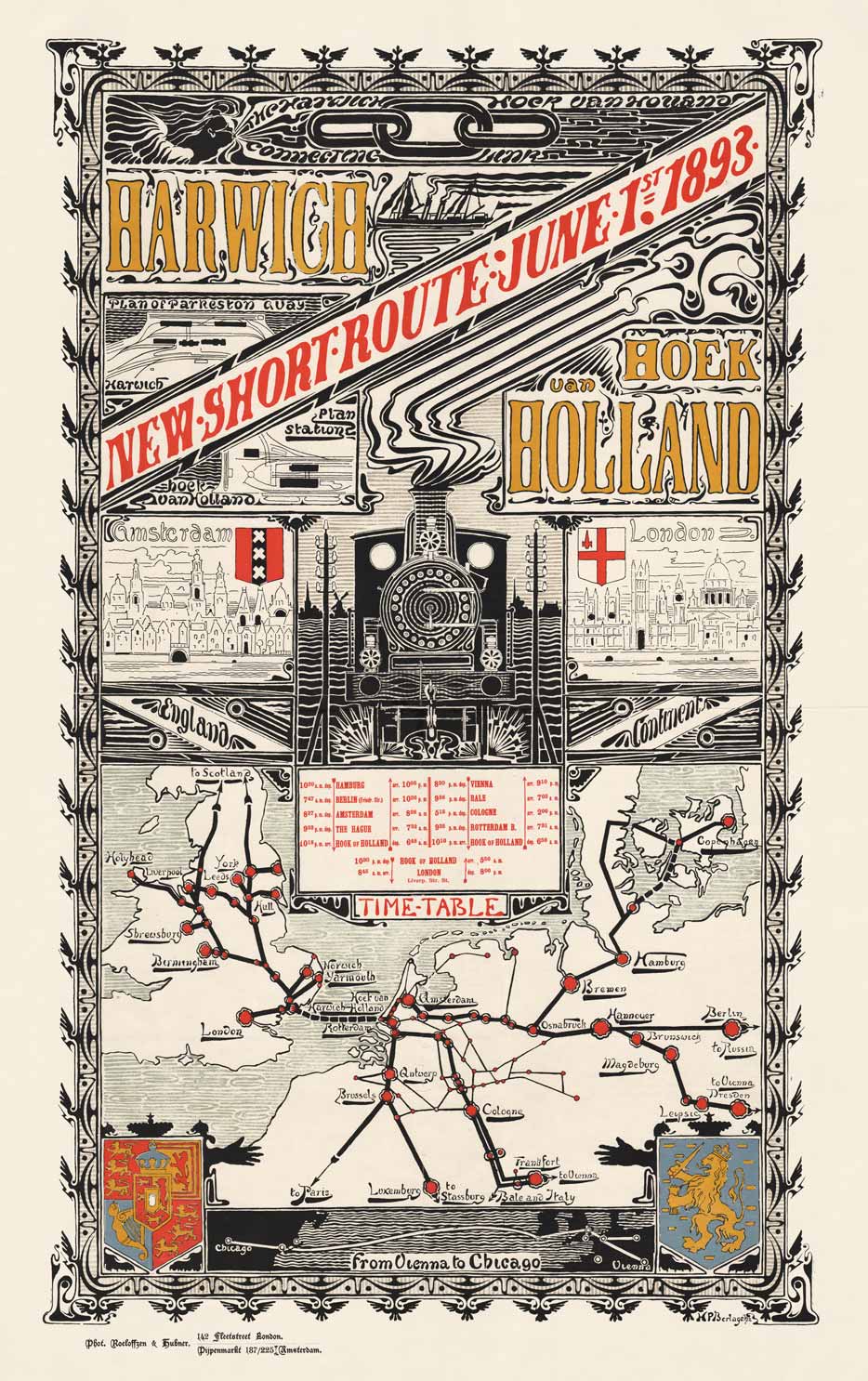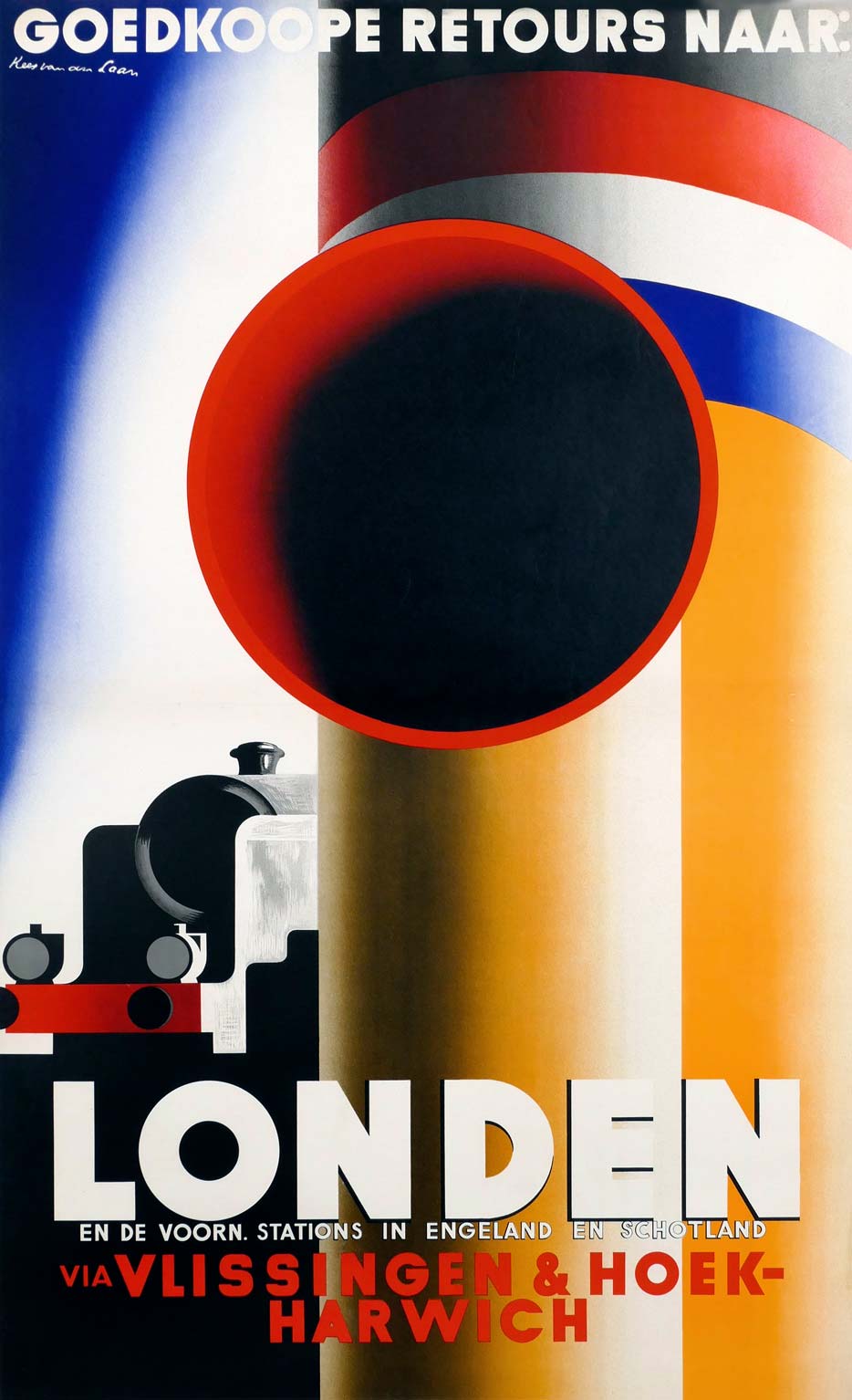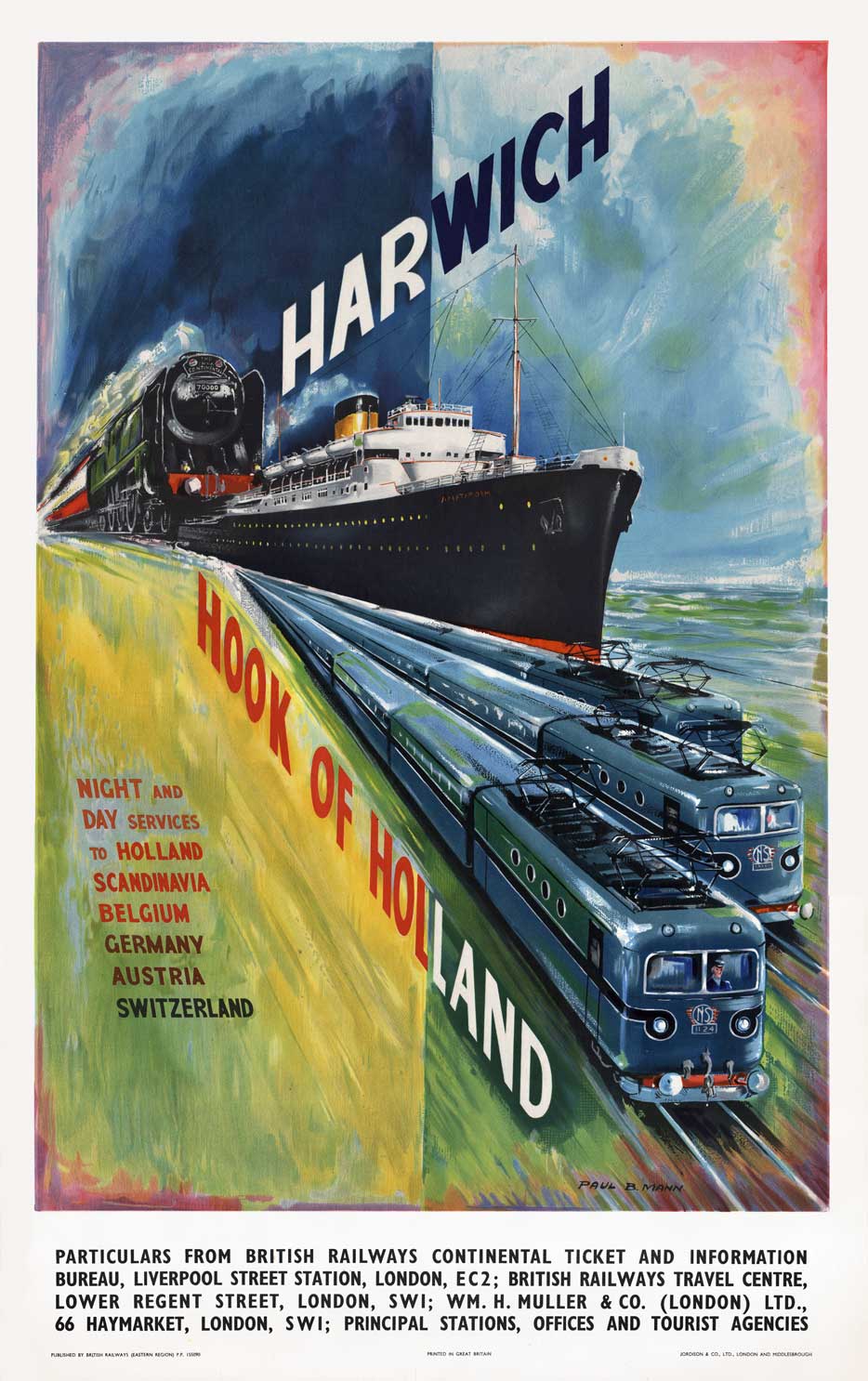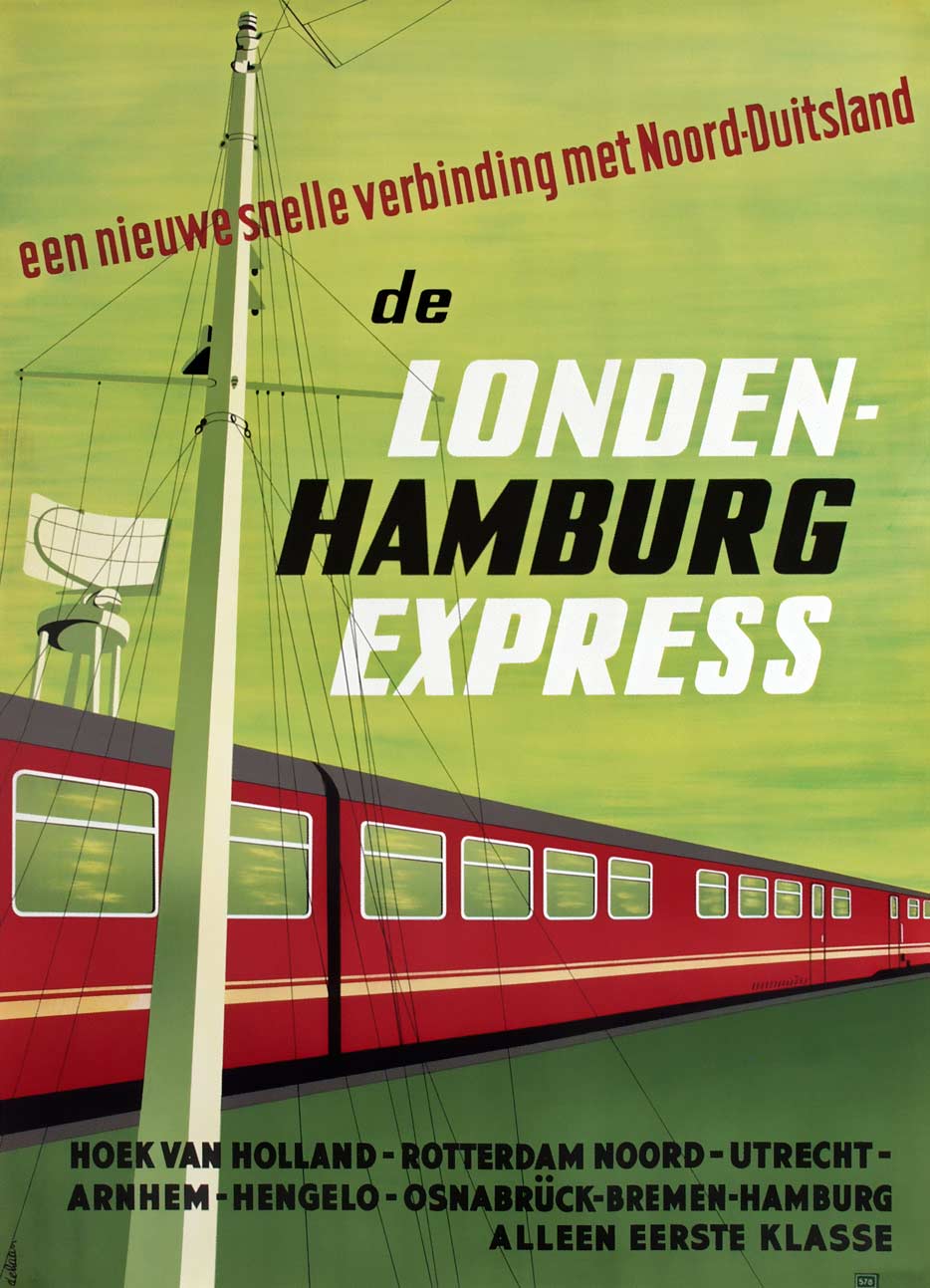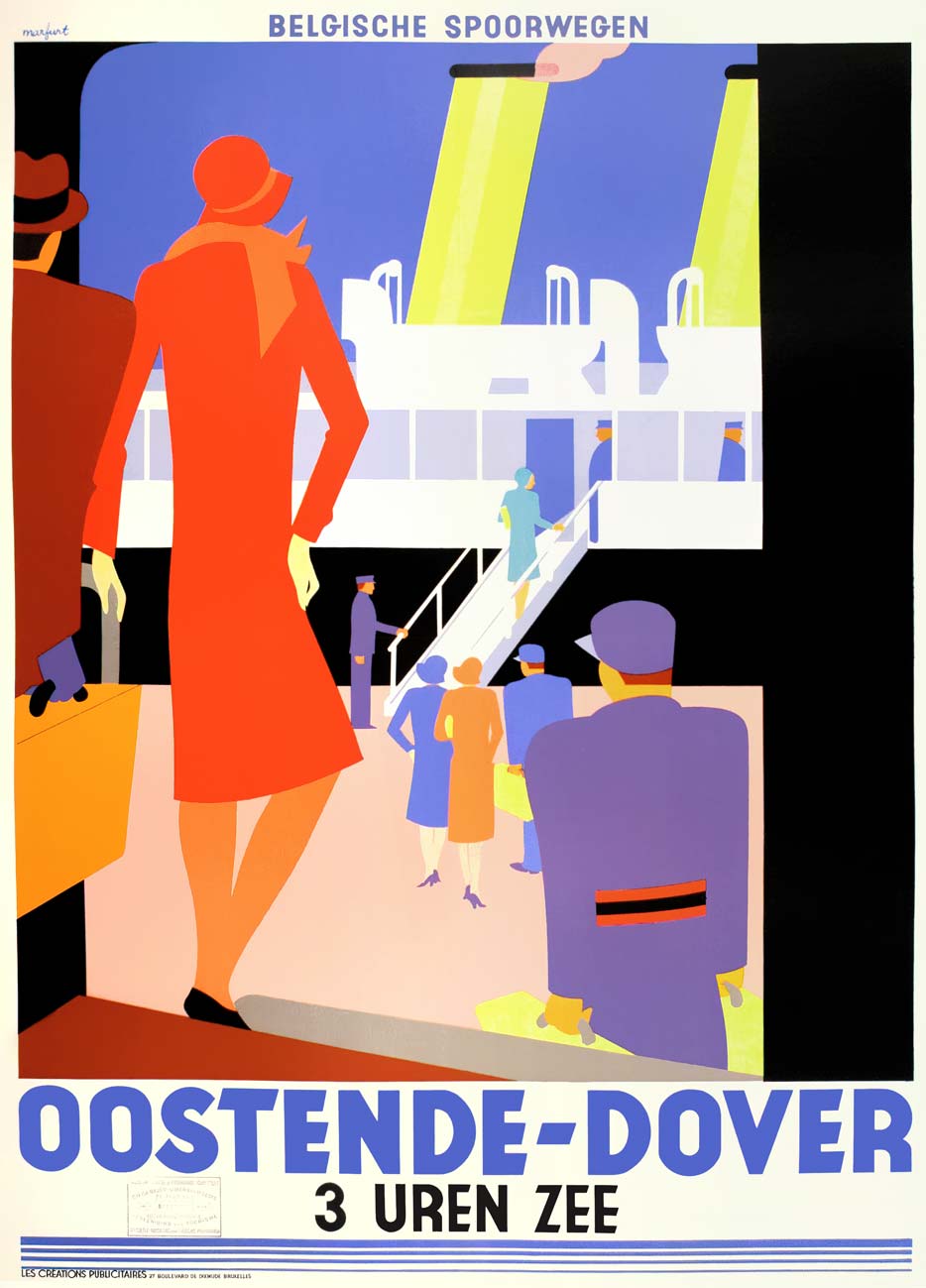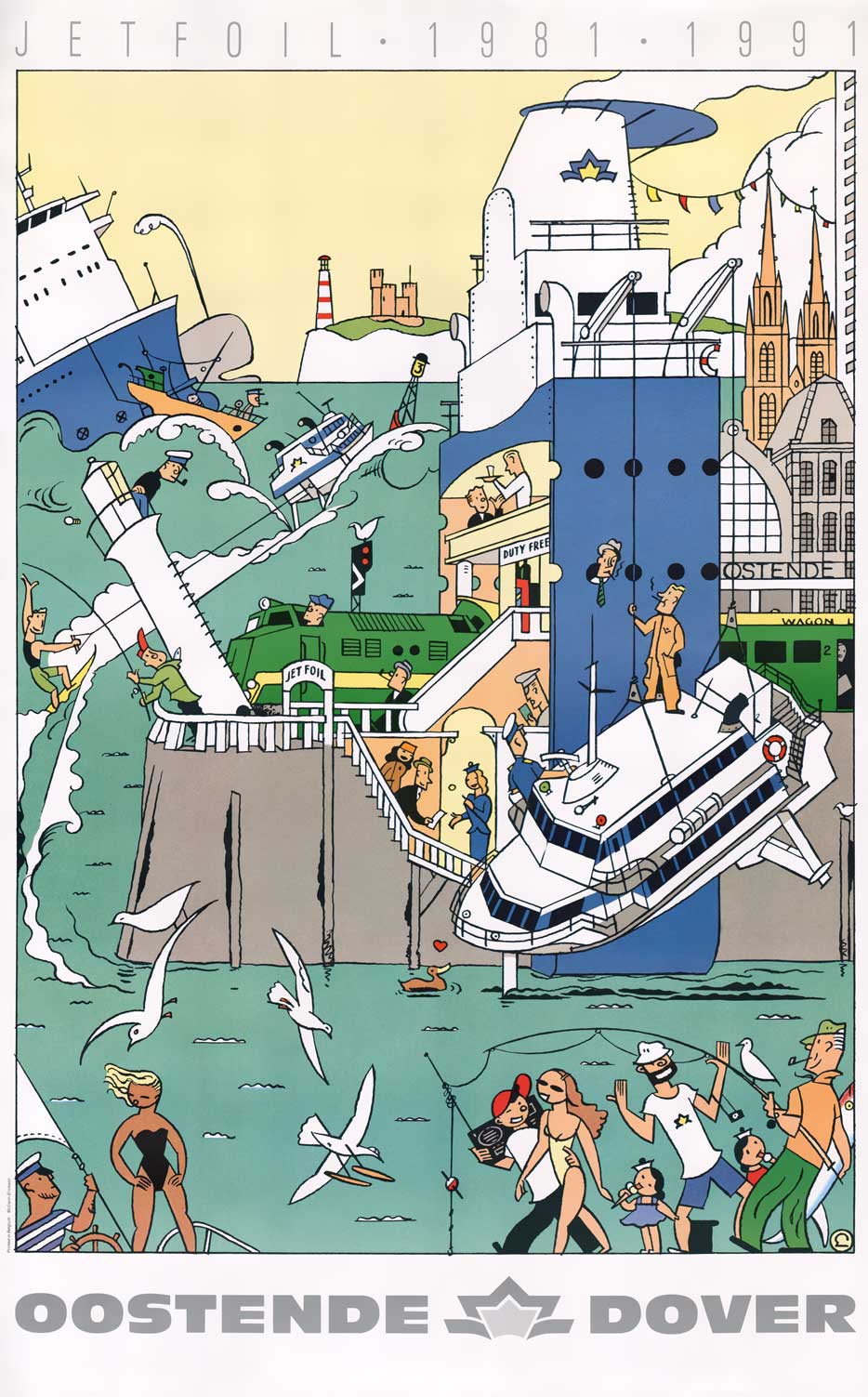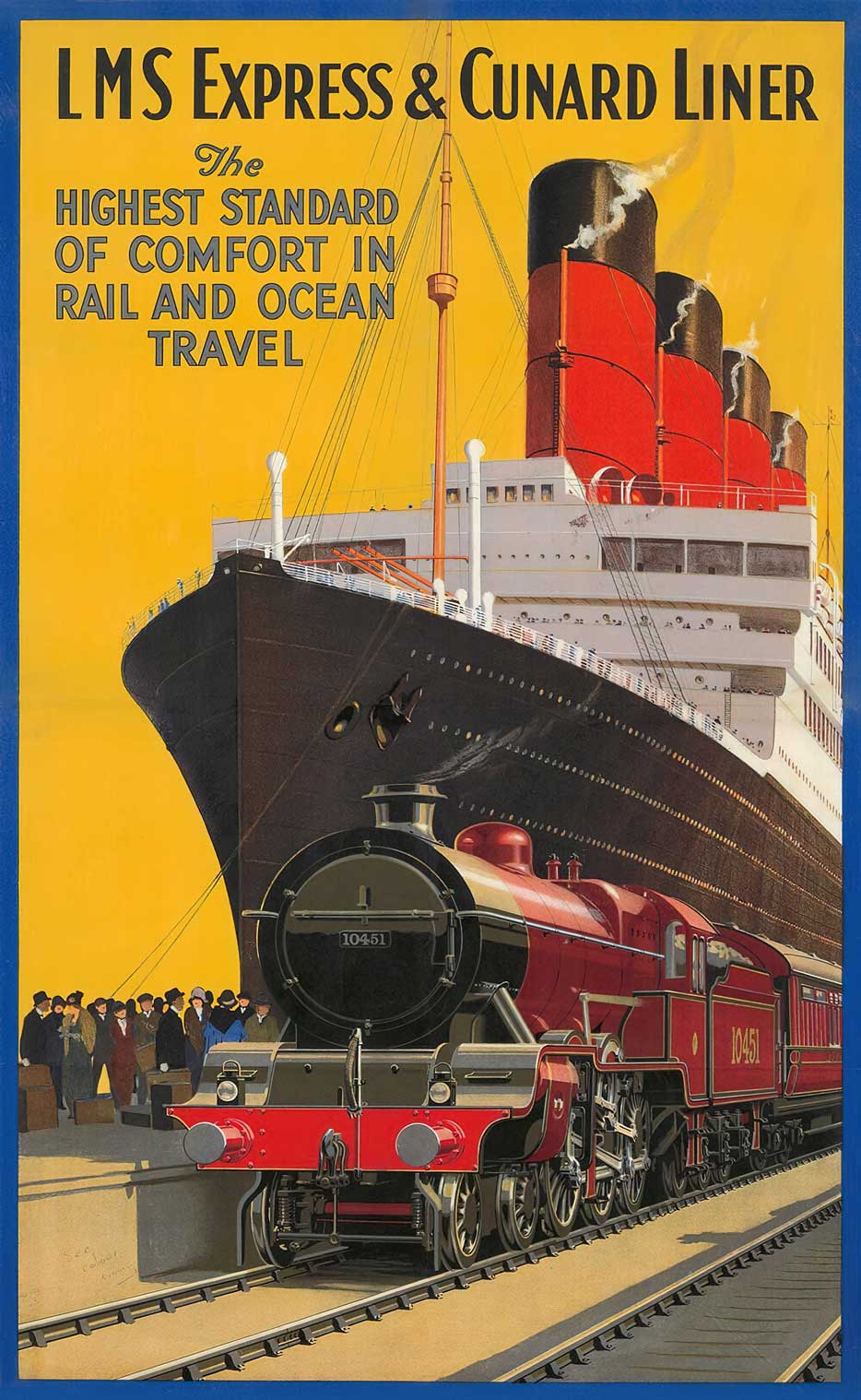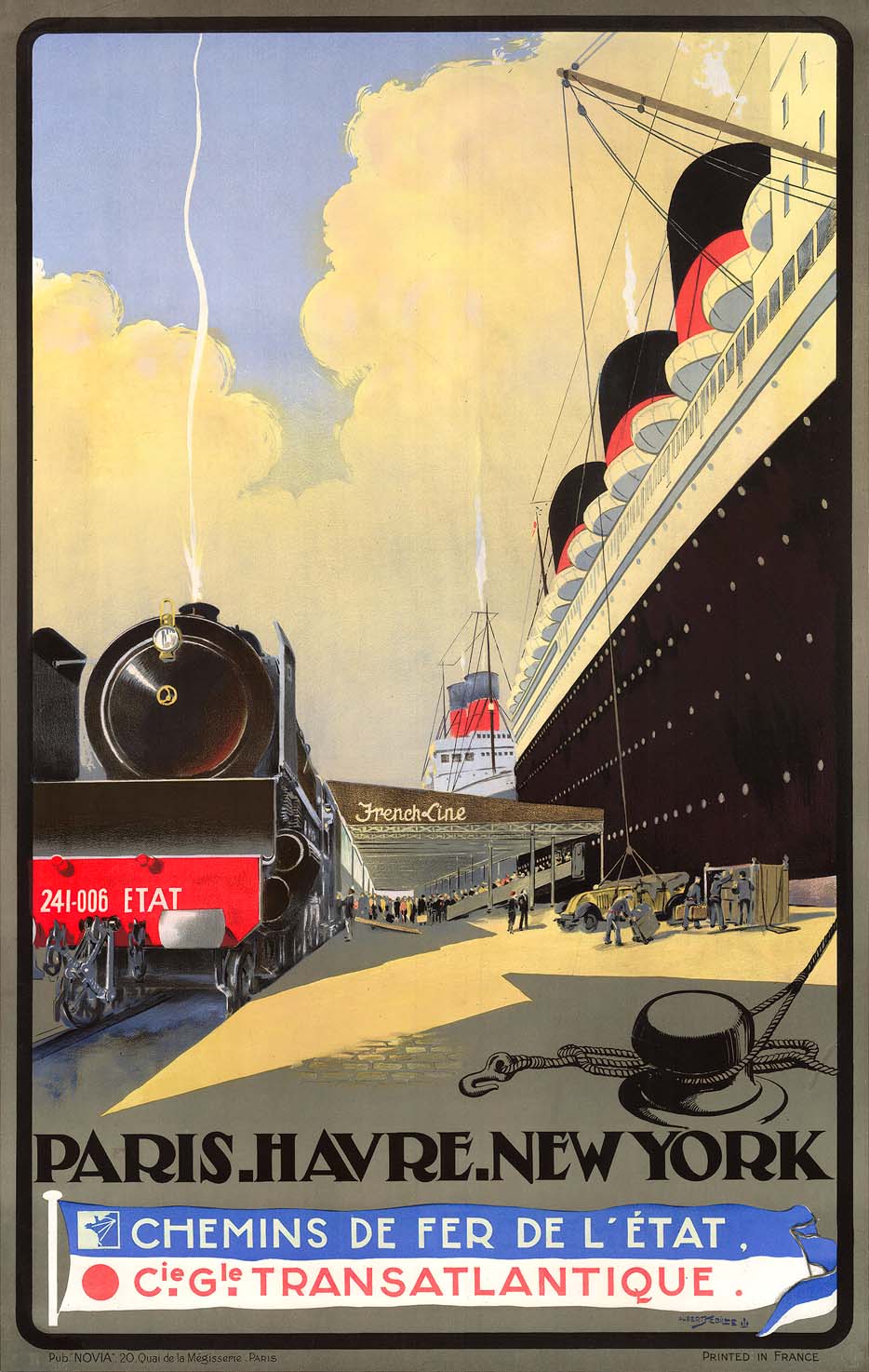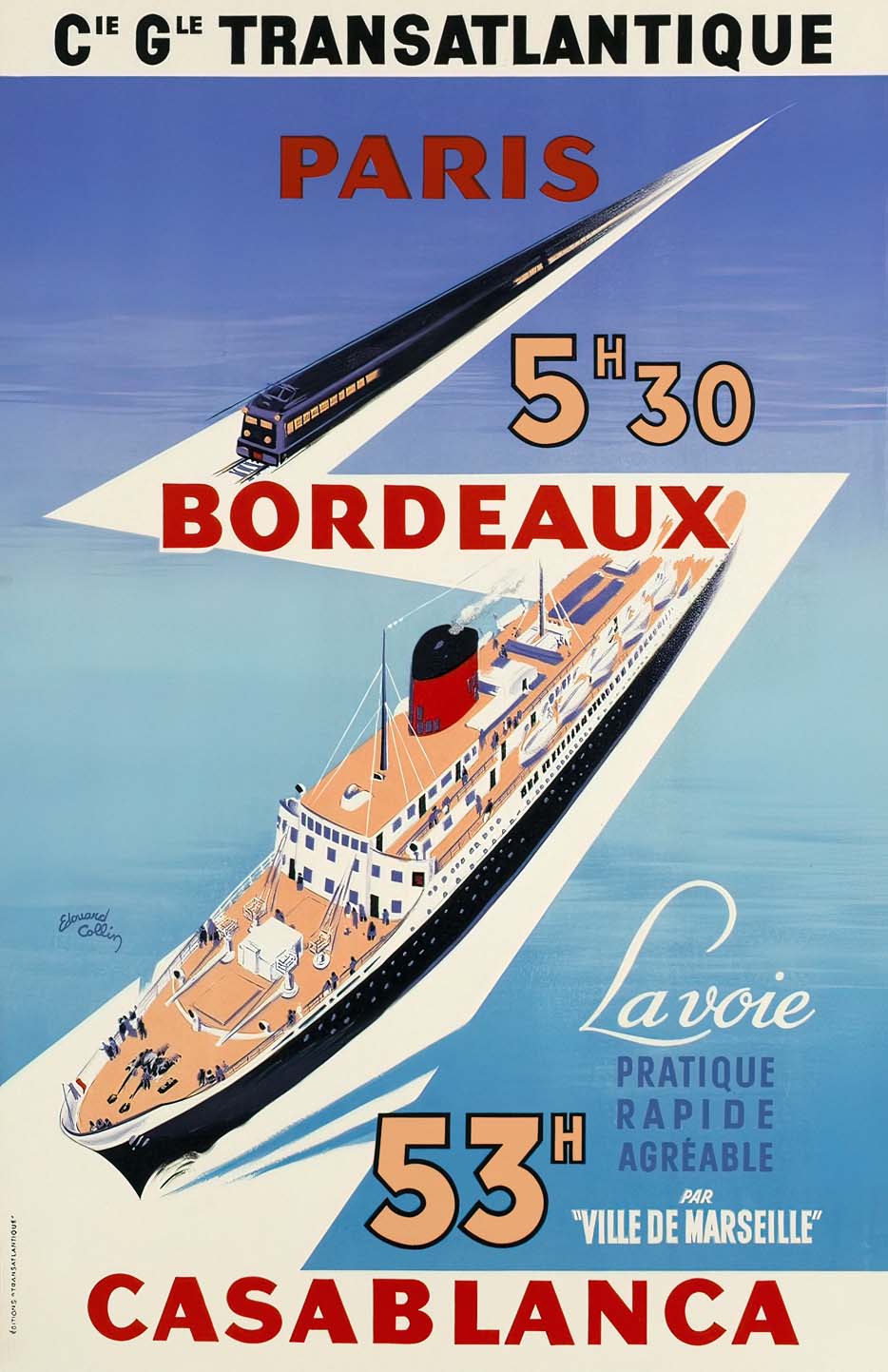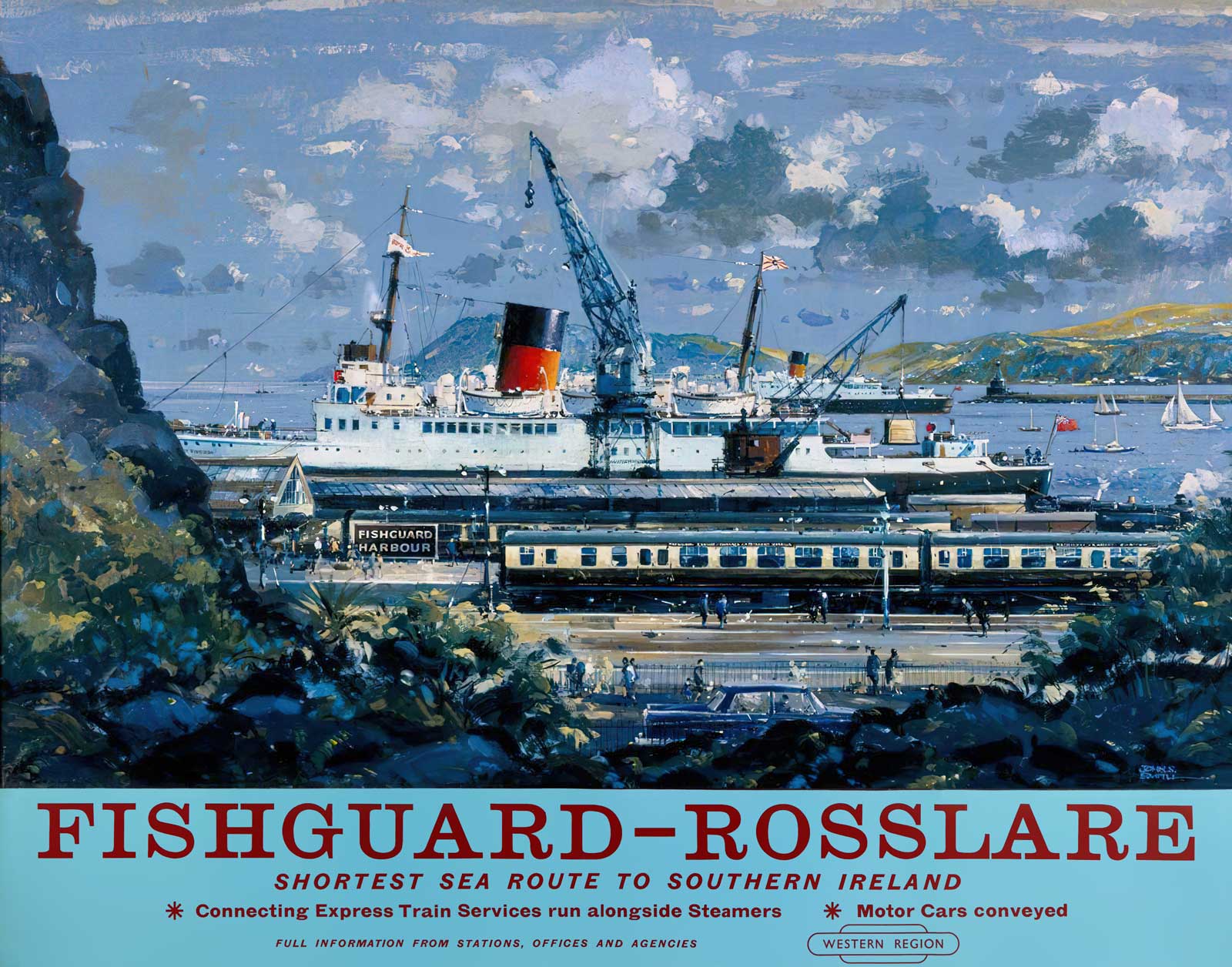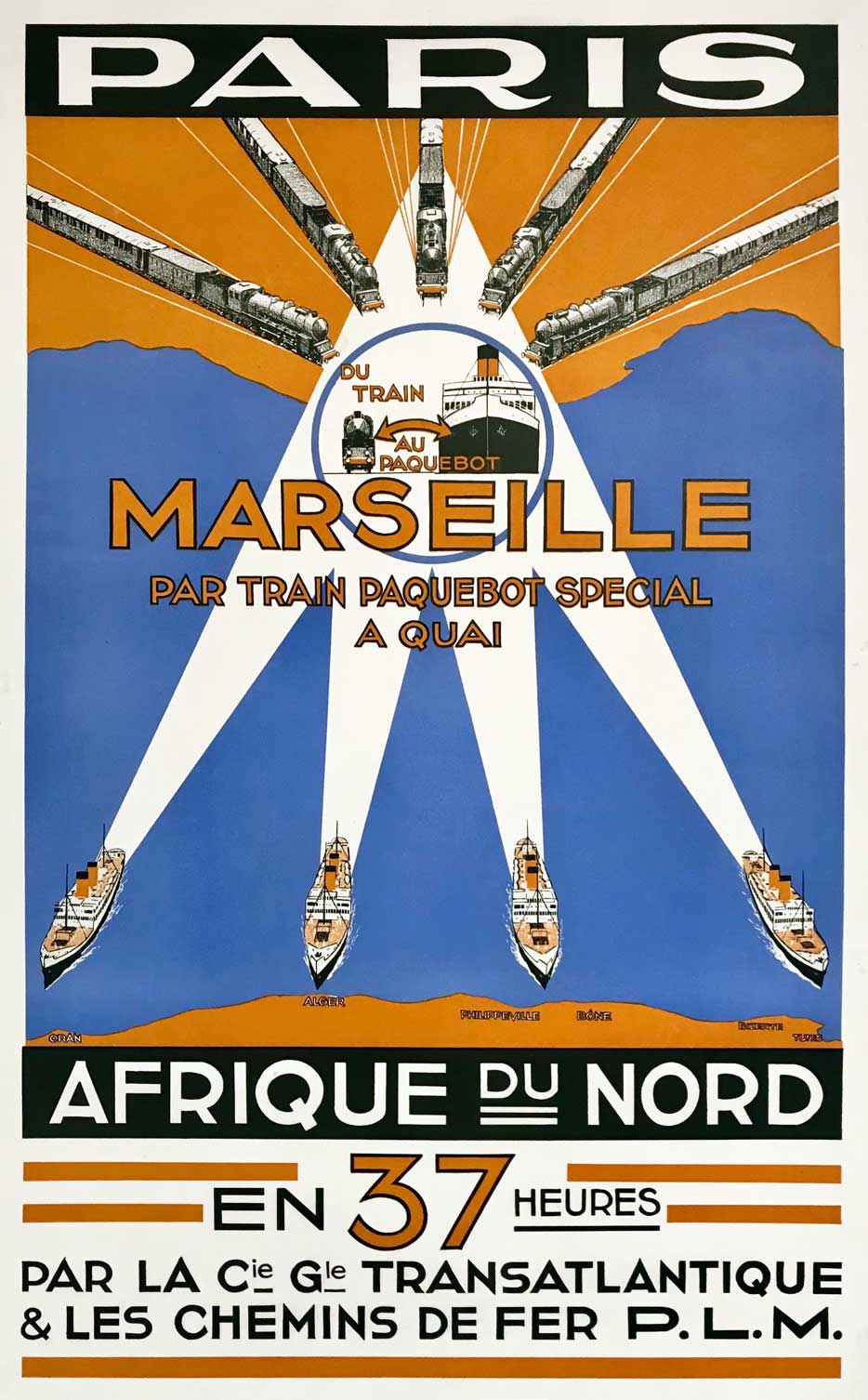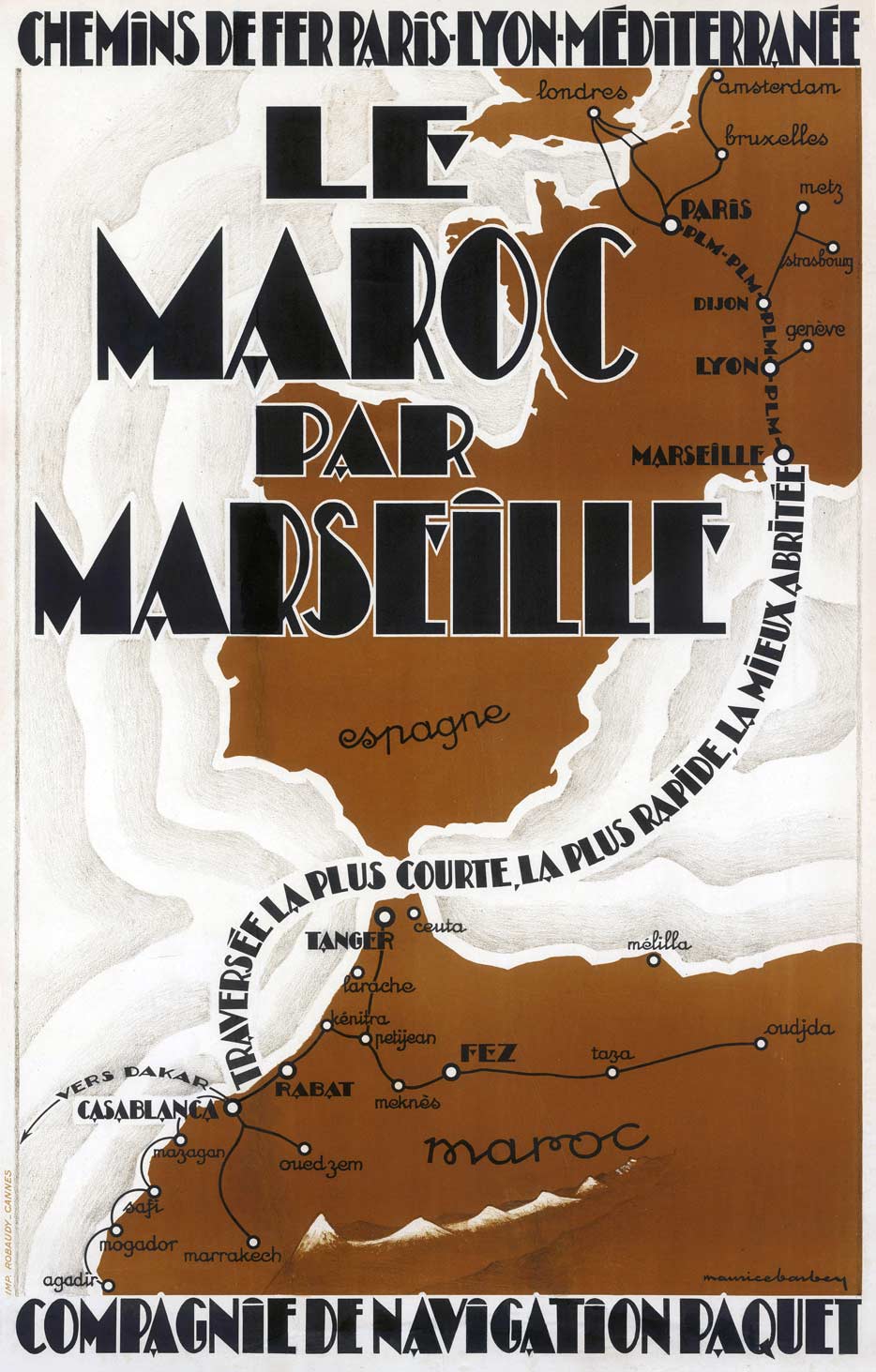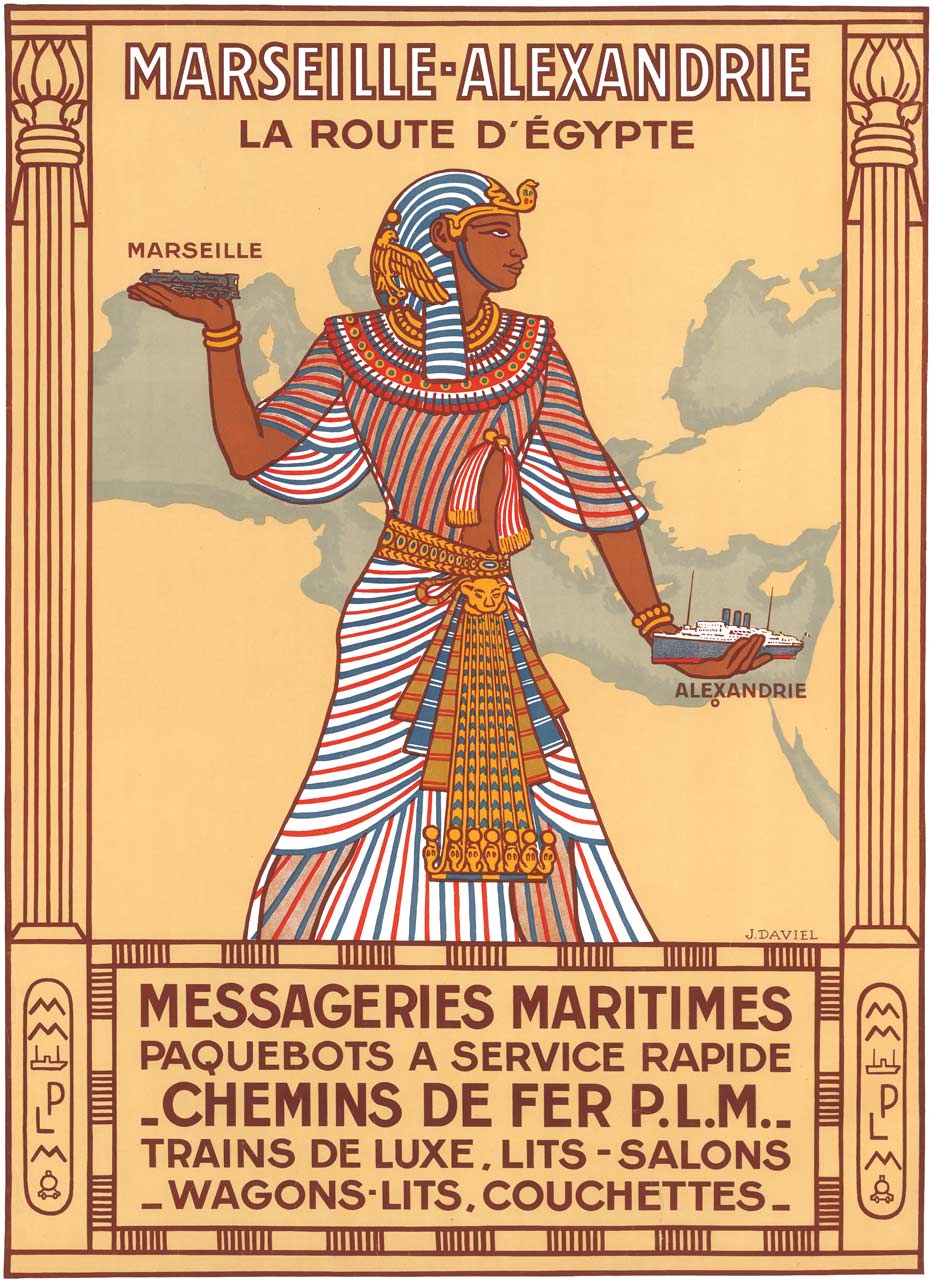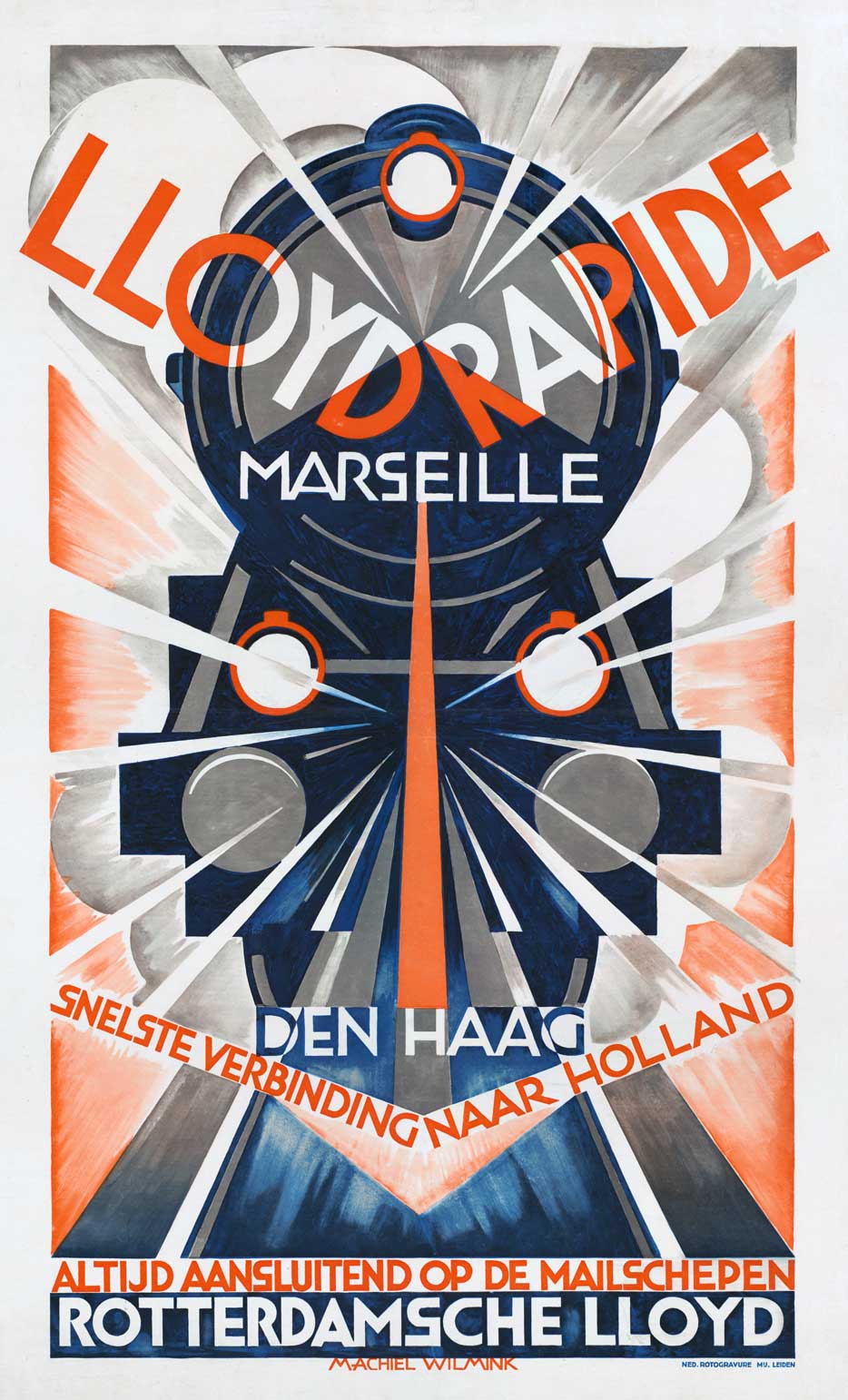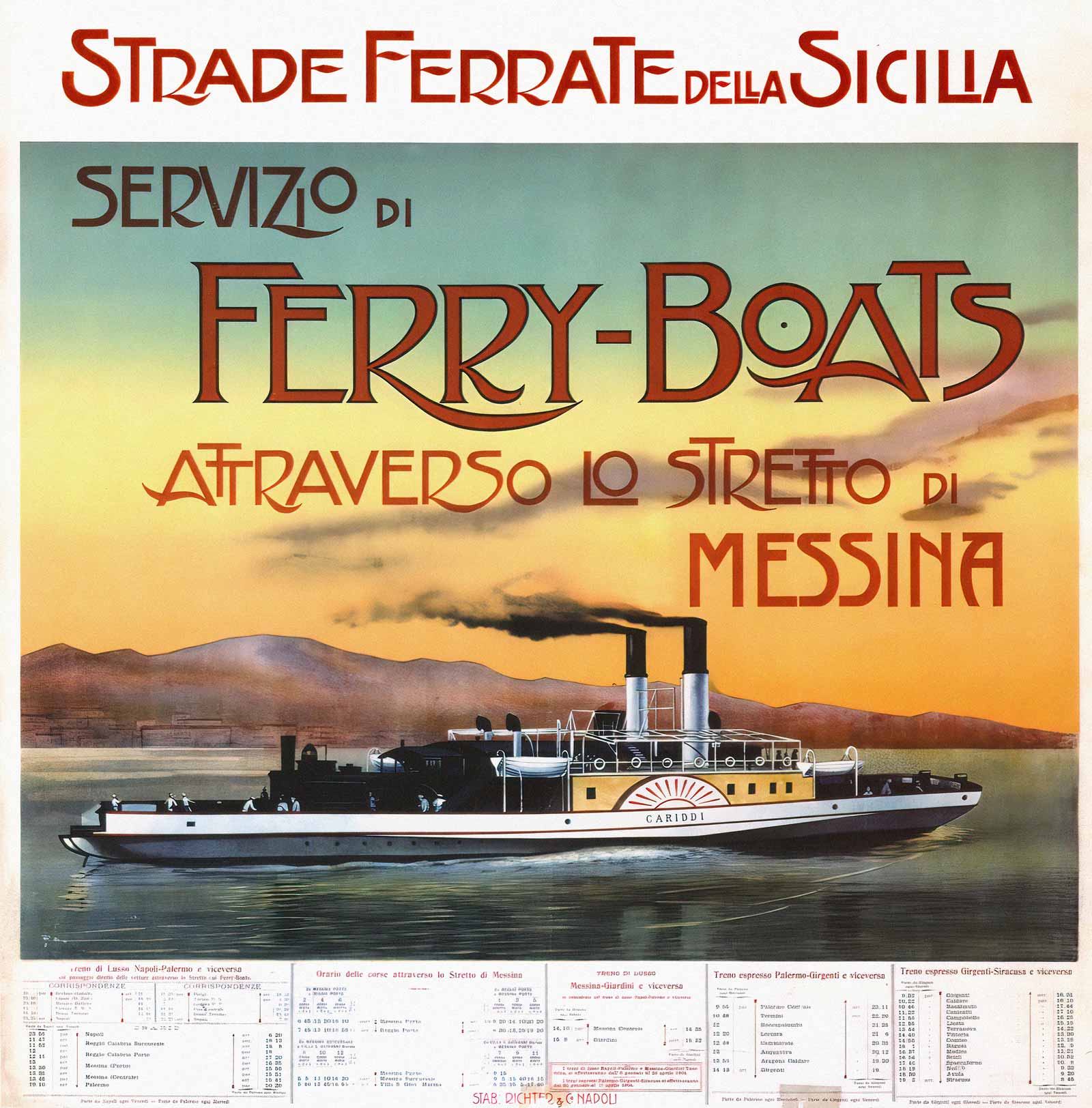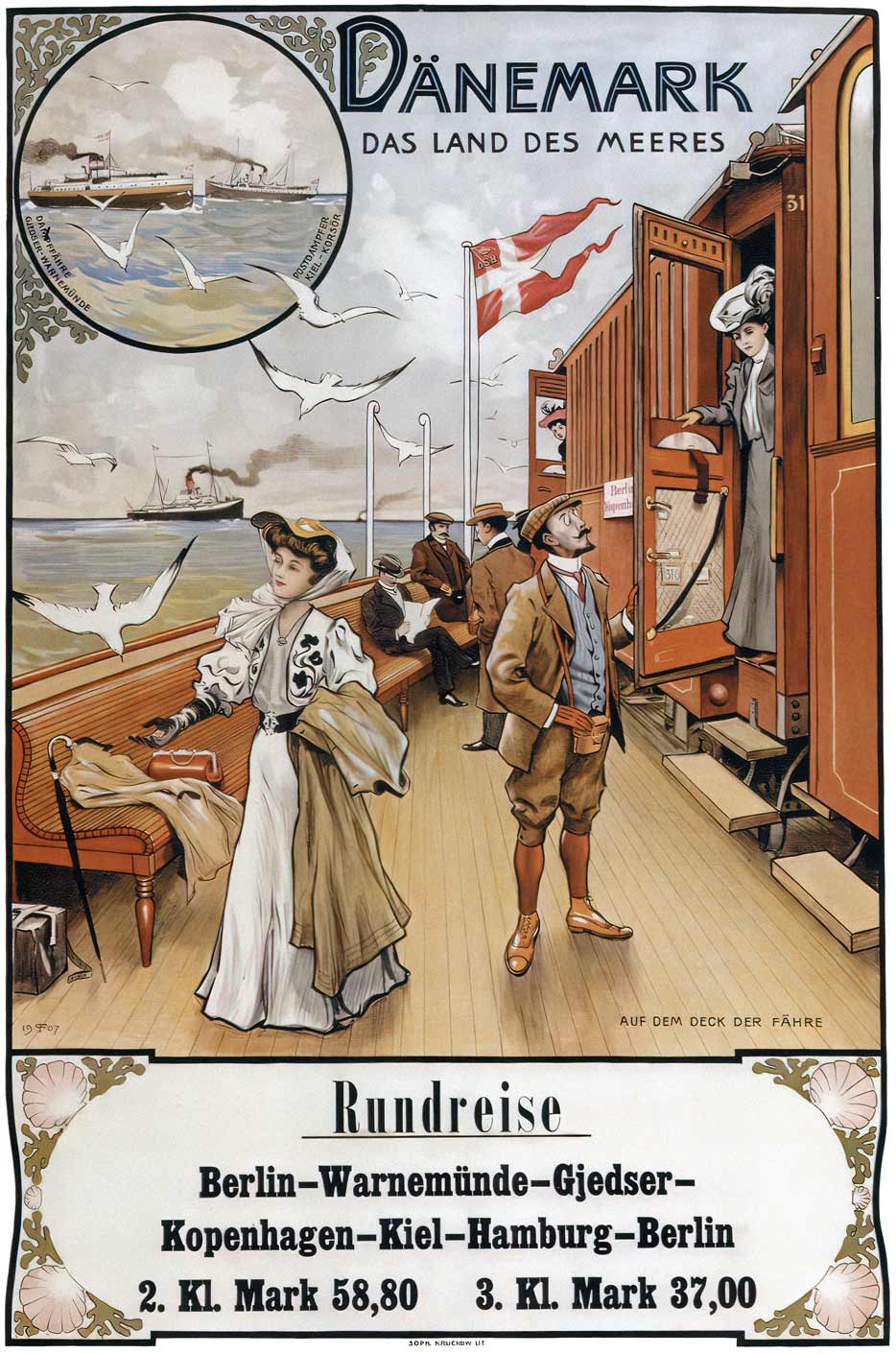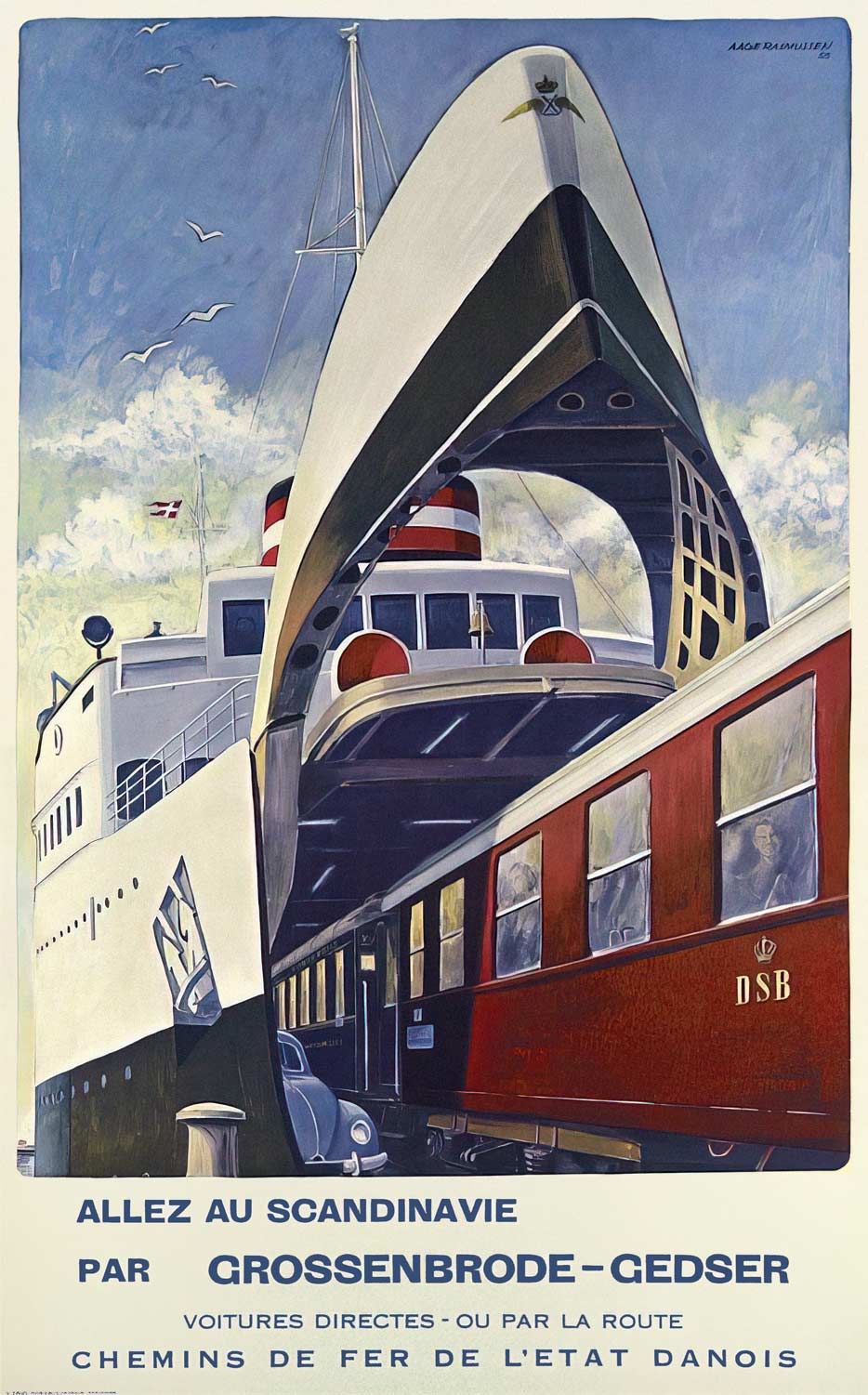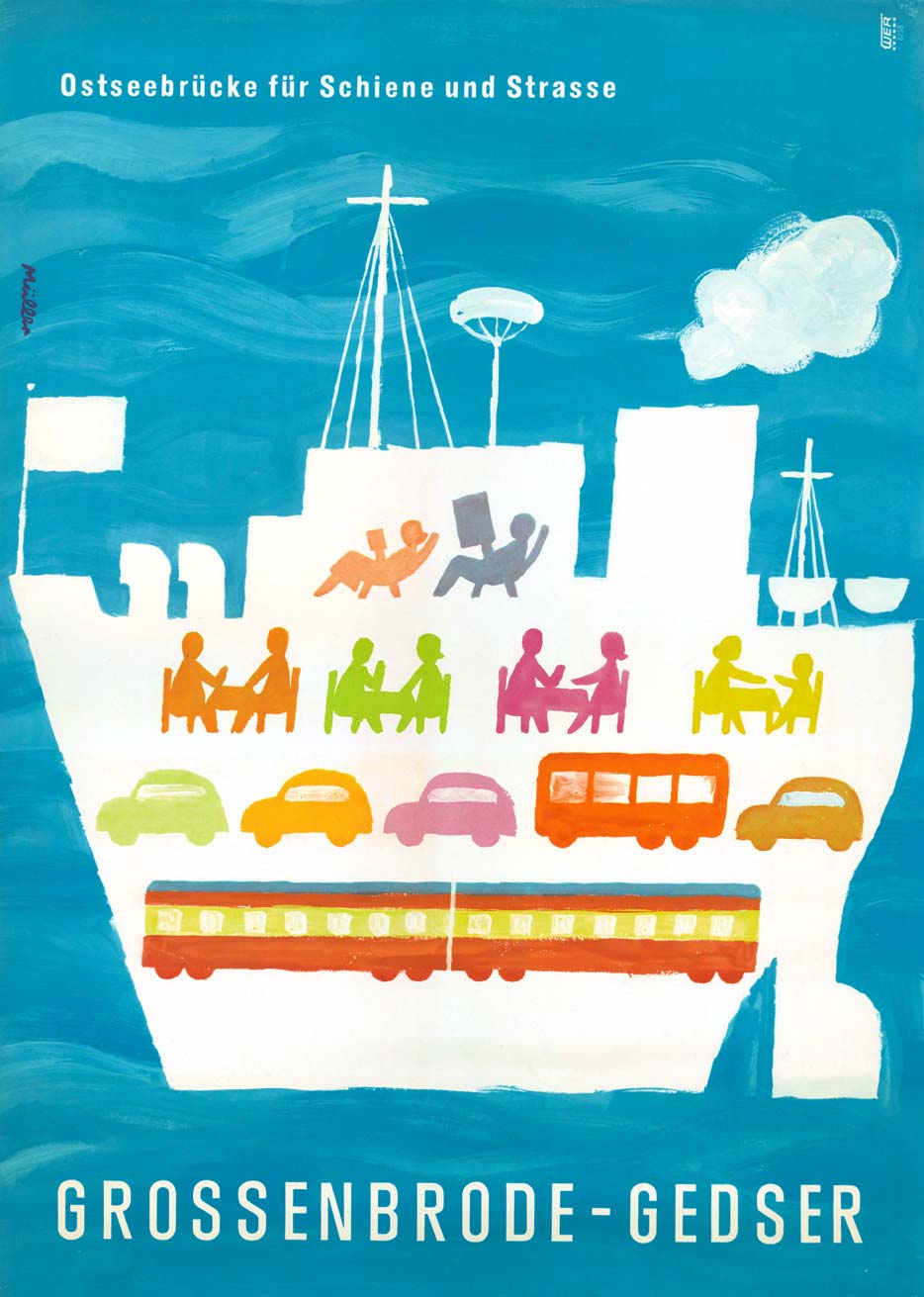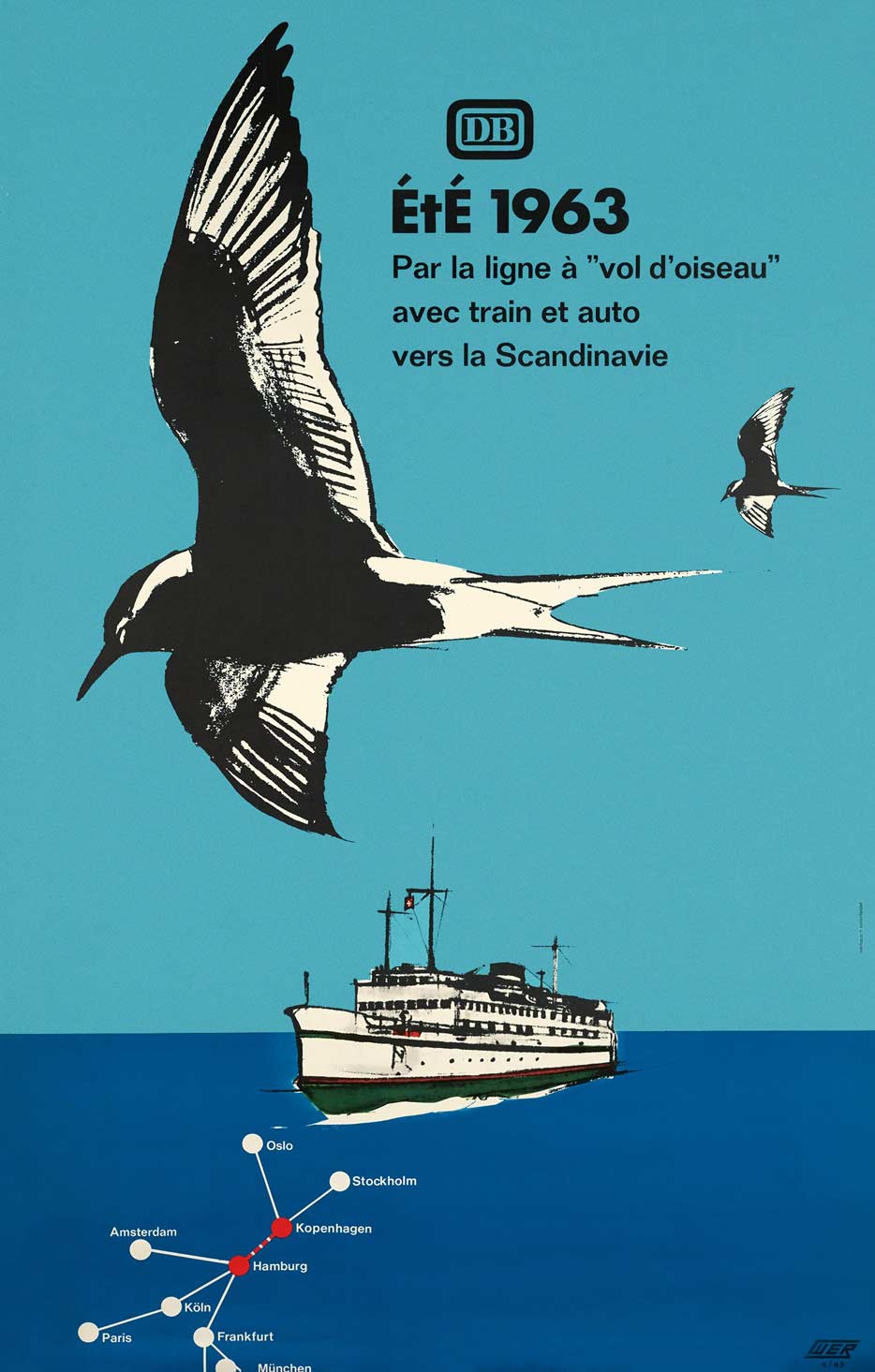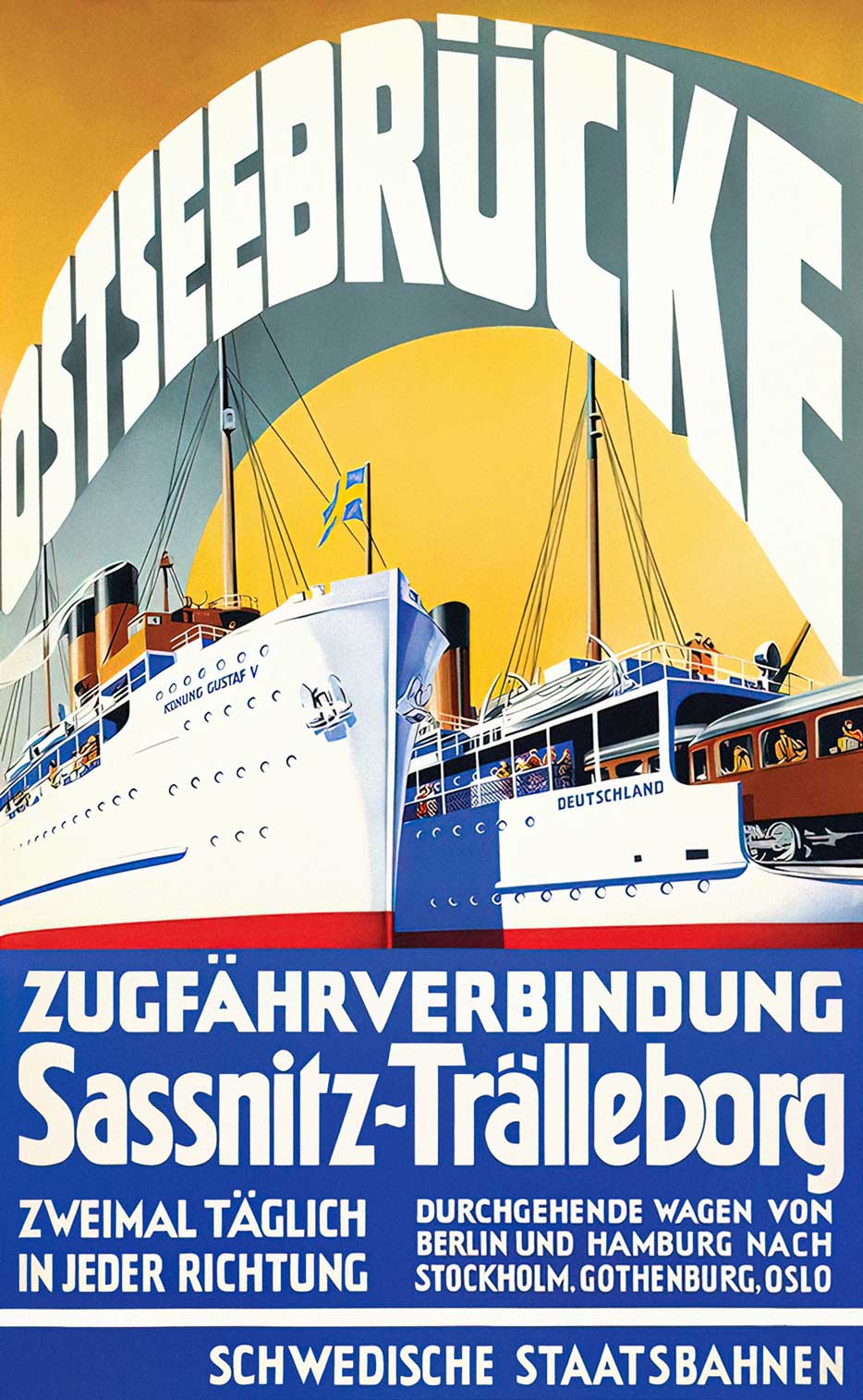Boat trains and train ferries
Railway posters as shipping posters
 Nederlandse versie
Nederlandse versie
Some railway posters are also shipping posters. In the second half of the 19th century, boat trains were introduced that linked to ferry services, which were often set up by railway companies. The two modes of transport complemented each other with transfers directly on the quay.
Boat trains provided connections to short crossings from England and Scandinavia to the European mainland. They also connected to large ocean liners departing for other continents. A special case were train ferries that enabled trains to roll-on and roll-off for an uninterrupted travel experience. Boat trains have inspired some of the most successful railway posters.
The Channel
For centuries, shipping services across the Channel have linked the European continent with England and Paris to London. Since 1850 special express trains were running on either side, connecting the capitals to seaports such as Folkestone and Boulogne-sur-Mer. Sleeping and dining car company Wagons-Lits introduced the first real boat train in 1889 on the occasion of the Paris World Exhibition. This Club Train offered an integrated one-ticket connection between London and Paris. On the quay a smooth transfer was provided to a ship linking Dover and Calais. On the other side the journey continued by train. The crossing took 70 minutes, the total journey 7 hours.The Club Train was meant for an affluent audience — the same target audience as the Jockey-Club de Paris, after which the train is said to be named. A smoking lounge was present between London and Dover and a dining car between Calais and Paris.
Already in 1893 the cooperation between Wagons-Lits and the London, Chatham and Dover Railway came to an end and the Club Train was terminated. Although separate boat trains continued to run, it took until 1926 before another integrated luxury connection between London and Paris existed. The Flèche d'Or (golden arrow) from Paris to Calais was launched on the occasion of a Wagons-Lits anniversary. This train, running on the Chemin de fer du Nord, consisted of luxury British Pullman parlor cars that Wagons-Lits had introduced on the continent. The connection from London to Dover was provided by the Continental Express of the Southern Railway (SR).
Full integration of boat and train followed in 1929 with the launch of the SS Canterbury, a ferry specially built for this service. From then on the Pullman train between Dover and London was 'symmetrically' called Golden Arrow.
Promotional posters literally pictured a golden arrow in both directions, printed in yellow and orange colors against a black or white background. The arrow incorporated the dynamic silhouette of a SR ship or a Nord locomotive. The designer was Charles Shepherd (1892-?), head of the studio of The Baynard Press.
In 1930 Southern Railway and the Chemin de Fer du Nord also issued a poster advertising 'la traversee la plus courte' (the shortest crossing), on which the steam from locomotive and ship dissolves into clouds and waves. In addition to the Golden Arrow it also promoted more affordable cross-Channel connections.
Southern Railway also collaborated with other railway companies serving French and Belgian ports, as a 1933 poster by Pat Keely shows. The Channel is depicted in a bird's eye view as a long strait between white cliffs. The Chemins de fer de l'État, for example, were serving Le Havre and Dieppe, where ships departed for Southampton and Newhaven. A particularly modernist poster by Roger de Valério shows six boat trains on both sides and as many ships in the Channel. Due to the parallel placement and schematic representation, it resembles infographics as designed by Gerd Arntz in the same period.
Night Ferry
Before the Eurostar in 1994, the only direct connection between London and Paris was the Train Ferry, later called Night Ferry. This service existed from 1936 to 1980. In the evening travelers boarded a sleeping car at the Gare du Nord in Paris or at London Victoria Station and woke up in the other capital the next morning. At Dunkirk or Dover the carriages were driven on a train ferry while the passengers slept on. The connection was operated by Wagons-Lits, Southern Railway and the Chemin de Fer du Nord. The latter two soon became part of the national railway companies SNCF and British Rail.
The service was using one of Southern Railway's three train ferries: the SS Hampton Ferry, SS Twickenham Ferry or SS Shepperton Ferry. In the ship's hold the carriages were secured on four parallel railway tracks to distribute the weight evenly. At the ports of Dover and Dunkirk special closed docks with locks kept the ferry at level with the tracks on the quay. At high tide the ship could sail directly in or out of the dock, while at low tide water had to be discharged or pumped up first.
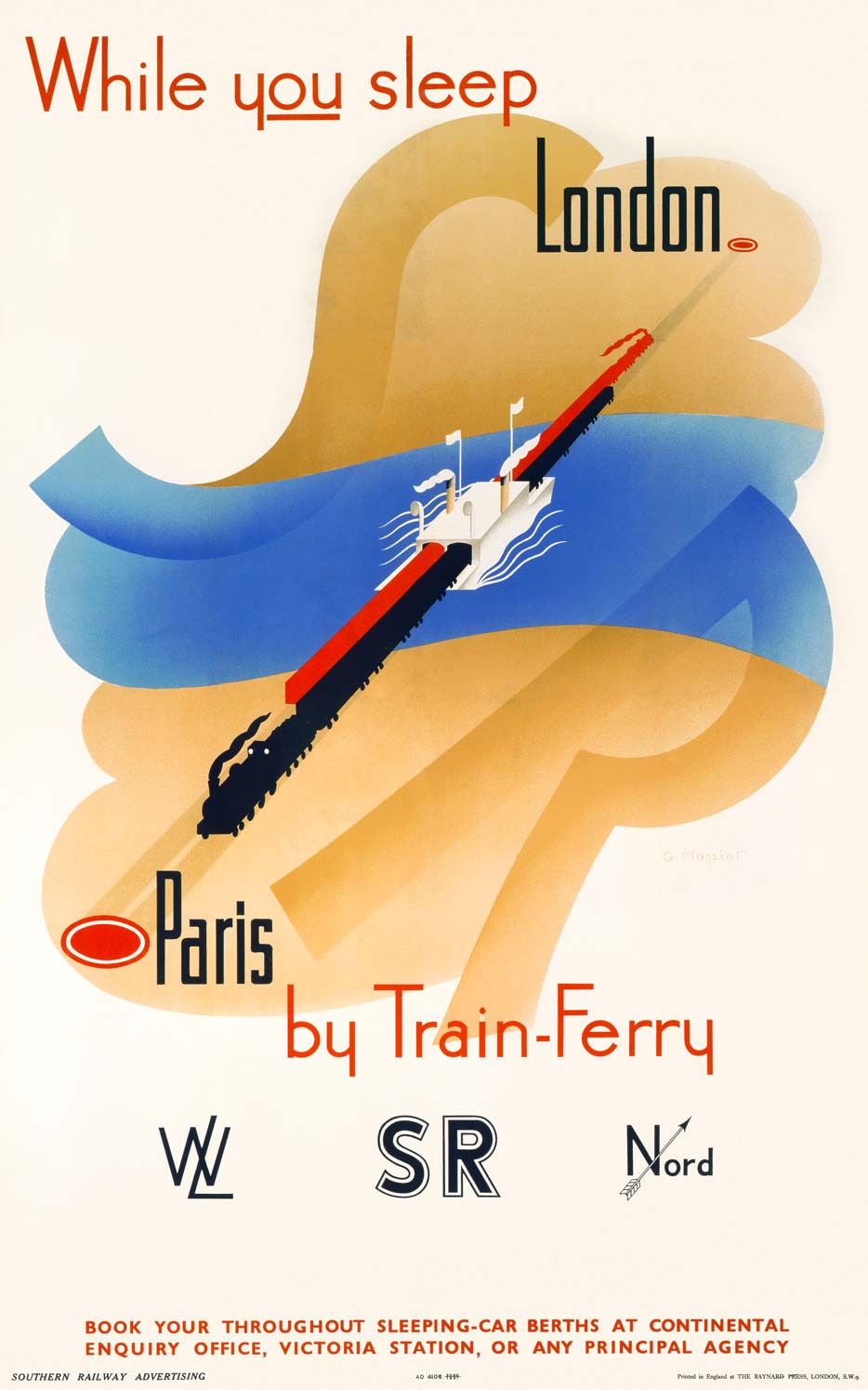
On the poster While you sleep by Scottish designer George Massiot Brown (1881-1961), the train makes a straight line between London and Paris with the ferry in the middle. Below are the monograms WL (Wagons-Lits), SR (Southern Railway) and Nord (Chemin de fer du Nord).
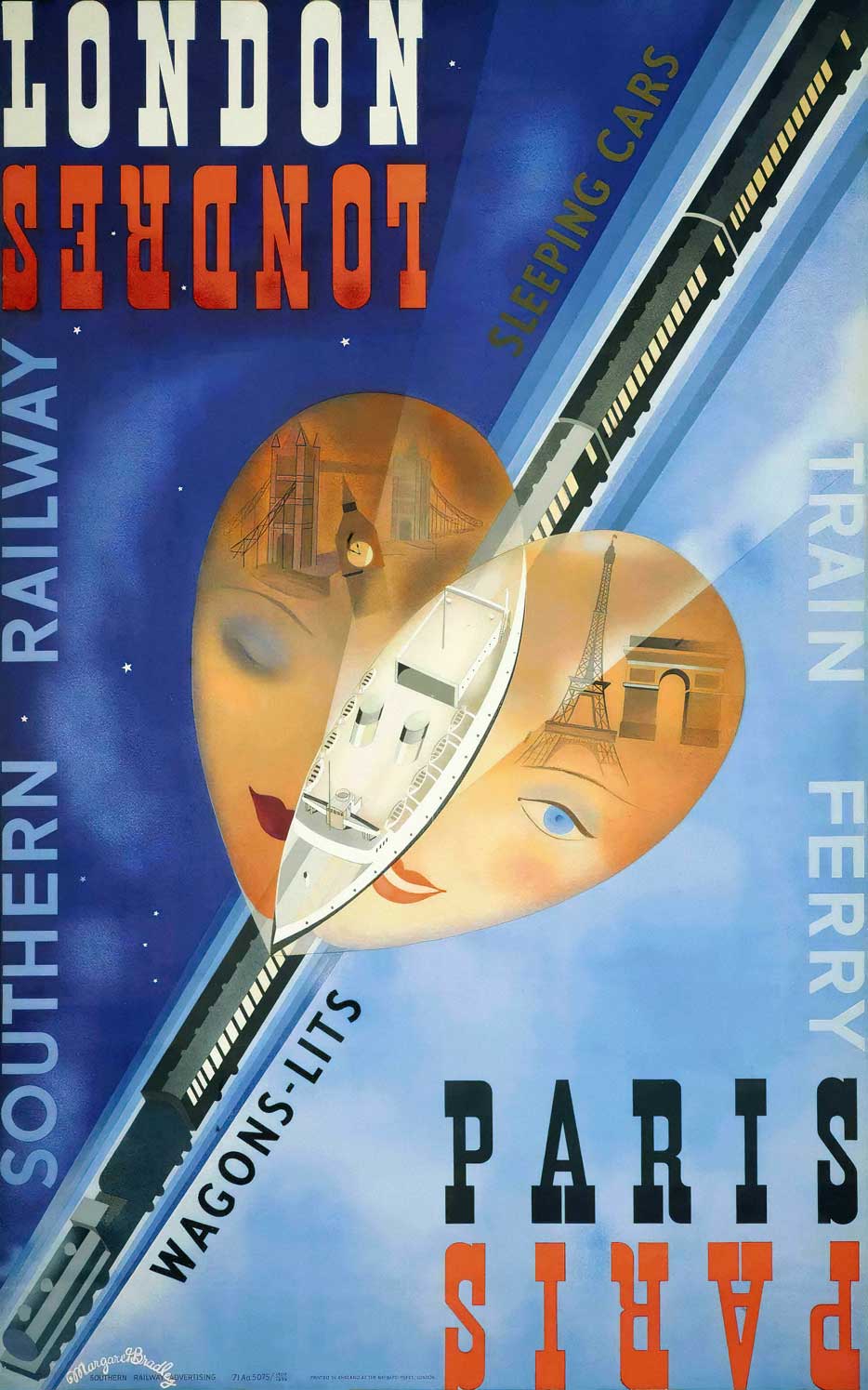
On a slightly later design by Margaret Bradley the straight line is visible once more. The blue background creates atmosphere, as does a stylized heart with female faces and impressions of London and Paris. It's night in one of the capitals, in the other morning has broken.
Bon Voyage
The Second World War interrupted international rail traffic and cross-Channel services. The Golden Arrow did not run again until April 1946. During the war the monumental station building of Calais Maritime had been destroyed. The provisionally restored station consisted of little more than two platforms bordering directly on the quay.
The large poster Bon Voyage from 1952 shows how trains and ships meet at Calais to exchange passengers. On platform 2, Pullman carriages of the Flèche d'Or are waiting, while the SS Invicta (with British flag) and the SS Côte d'Azur (with French flag) are moored. Meanwhile the Invicta had replaced the Canterbury as the flagship of Southern Railway, which was now absorbed into British Railways.
The vibrant quayside scene was painted by Terence Cuneo (1907-1996), who had followed in the footsteps of his parents Cyrus and Nell Cuneo. After studying at the Chelsea and Slade art schools, he became best known as a railway painter, his work featured on many British Railways posters. However, Cuneo also created (royal) portraits, ceremonial pieces and landscape paintings.
Although electrification of railway lines accelerated travel time from London to Paris in the post-war decades, competition from airplanes, cars and hovercraft slowed demand. The last Flèche d'Or from Paris to London left on 30 September 1972. With the opening of the Channel Tunnel in 1994 the Calais-Maritime station was closed.
The North Sea
Since 1875 the Zeeland Steamship Company (SMZ) sailed from the Dutch port of Vlissingen (Flushing) to Queenborough. In England the SMZ was cooperating with the London, Chatham and Dover Railway (LCDR). Many British took the 'Flushing route' to Germany, which was also important for mail traffic. In 1877 the SMZ received a royal predicate, after which the shipping company nicknamed itself 'Royal Dutch Mail'. A poster with that text from around 1885 shows the trains crossing the continent from Vlissingen by the 'Netherlands State Railway' (Staatsspoorwegen).
The Great Eastern Railway (GER) started a shipping connection between Harwich and Hoek van Holland (Hook of Holland) in 1893, when the Dutch port was provided with a station of the Hollandsche IJzeren Spoorweg-Maatschappij (HSM). Due to its more convenient location and shorter travel time, Hoek van Holland quickly gained popularity compared to Vlissingen. Dutch architect Hendrik Petrus Berlage designed an HSM poster promoting 'the new short route'. At the center of the modestly colored but crowded poster is a stylized steam locomotive, surrounded by the coats of arms of Amsterdam and London as well as station maps of Harwich and Hoek van Holland. The bottom half contains a map of international railway connections and the caption 'From Vienna to Chicago', which referred to the 1893 World's Fair in the American city.
After the First World War the ferry service to Hoek van Holland came under the operation of the London & North Eastern Railway (LNER). Meanwhile the Dutch railway companies HSM and Staatsspoorwegen were working together as Nederlandsche Spoorwegen (NS). The Vlissingen shipping company SMZ moved its port of arrival to Harwich and started to work closely with LNER. During daytime LNER-SMZ sailed to Vlissingen and at night to Hoek van Holland. From now on the two ferry services were promoted jointly.
In 1928 high-profile French designer A.M. Cassandre created the poster The Continent via Harwich for LNER. The dark bow of the ship coincided with the train moving diagonally across the image. The light and dark half also represented the day and night boat. The SZM released a Dutch variant with the caption 'Cheap tickets to London via Vlissingen-Harwich'. Ten years later Kees van der Laan (1903-1983) designed a poster for affordable return tickets to London, which also combined a locomotive and ship. 'He certainly learned from Cassandre, but he has proved to be an artistic and intelligent student', wrote Dutch cartoonist and journalist Cornelis Veth.
During the 20th century Hoek van Holland was the starting point of many international trains. For British passengers 'the Hook' was an important 'gateway to the Continent'. From there they traveled to destinations in Germany, Scandinavia, Eastern Europe, the Alpine countries, Italy and even the Balkans. The three platforms of Hoek van Holland's harbor station were filled with international trains, as an English poster from around 1955 shows. In addition to the motor ship Amsterdam, three electric locomotives of the NS 1100 series are depicted, as well as the steam locomotive of 'The Hook Continental', the connecting boat train of British Railways (BR). The poster designer, Paul Mann (1903-1974), was an illustrator for Railway Magazine and creator of the instruction book How To Draw Locomotives.
Also departing from Hoek van Holland was the Holland-Scandinavia Express to Copenhagen. From 1947 onwards its route went via Osnabrück, Bremen, Hamburg and the train ferry at Puttgarden. In 1957 the luxurious and fast London-Hamburg Express was launched, which connected tightly with the Harwich ferry at Hoek van Holland. Mainly aimed at short business trips, passengers could travel between London and Hamburg for the first time without spending the night on a train or boat. The poster by NS designer Jan de Haan (1917-1975) featured a ship's mast and a radar antenna as symbols of the North Sea crossing and the port city of Hamburg. Due to lack of interest the London-Hamburg Express was terminated after only two years.
Ostend-Dover
Since 1846 mail boats had been sailing between Oostende (Ostend) in Belgium and Dover in England, connecting to the railways on both sides. In 1905 the link was boosted by the commissioning of turbine ships. In 1923 a new 110-metre ship called Princesse Marie-José reduced crossing time to just under three hours. A few years later a poster promoted the fast service.
The seemingly simple image consists of highly stylized shapes without any depth effect. The fashionable passengers, seen from the back, are shown as silhouettes. The transfer from train to boat is presented as very streamlined; helpful staff is abundant. The black contours of the train's door blend seamlessly with the ship's bow. The poster was designed by Leo Marfurt (1894-1977), a Swiss who had been working in Belgium for several years and had his breakthrough as an innovator of the Belgian poster, as Cassandre was in France.
Many decades later, in 1981, the Regie voor Maritiem Transport (RMT) commissioned two fast Boeing 929 jetfoils (hydrofoils) between Ostend and Dover. This was in anticipation of the announcement of the Channel Tunnel. Travel time was reduced to 100 minutes. To mark the tenth anniversary of the jetfoil, the well-known Belgian cartoonist and illustrator Ever Meulen (1946) created a colorful poster in which elements tumble over each other and ships seem to capsize. Ostend station, the green SNCB train and the 'flying' jetfoil are clearly distinguishable. Ever Meulen also created illustrations and covers for the magazines Humo, OOR and The New Yorker. After the opening of the Eurotunnel and Eurostar, the Ostend-Dover ferry service was discontinued.
The Atlantic
In addition to short crossings within Europe, boat trains offered connection to the large ocean liners. Between the two world wars transatlantic passenger travel was flourishing, which is also reflected in posters. The British Cunard Line operated a 'fast' regular service between Liverpool and New York. The boat train from London Euston ran to Liverpool Riverside station, directly along the ocean terminal at Pier Head.
Shortly after the creation of the London Midland & Scottish Railway (LMS) as a merger of small railway companies, the LMS Express & Cunard Liner poster was issued. Together the two rail and shipping companies were able to offer 'The highest standard of comfort in rail and ocean travel'. Pictured is the RMS Aquitania, nicknamed 'the Ship Beautiful', built in 1913. On the platform in front of it is the 1923 'superheater express' locomotive LMS 10451, flanked by passengers with their luggage. A few years later an adapted version of the poster featured locomotive LMS 6100 'Royal Scot'. Creator was Frederic Gregory Brown, who had designed many posters for the London Underground since 1914 and later for other railway companies as well.
In addition to LMS, the London and North Eastern Railway (LNER) also provided rail connections to Liverpool. LNER did not link the port city to London but to the East Coast, where American en Canadian travelers could continue to 'The Continent' via Harwich, for example. An anonymous poster mentions the link to the Cunard services in Gill Sans font, which was part of the LNER house style since 1929. Diagonally in front of the Aquitania is locomotive 4472 'Flying Scotsman', LNER's showpiece.
Cunard's competitor on the transatlantic trade was White Star Line. In their race for the largest ship, White Star had launched the RMS Titanic in 1911. From 1922 White Star was once more able to show off the world's largest ship: the 291 meters long RMS Majestic. It had been built as a German ship for the Hamburg-America Line; after the First World War it was a reparation payment for a British passenger ship that perished during the war. The competitors Cunard and White Star would merge in 1934.
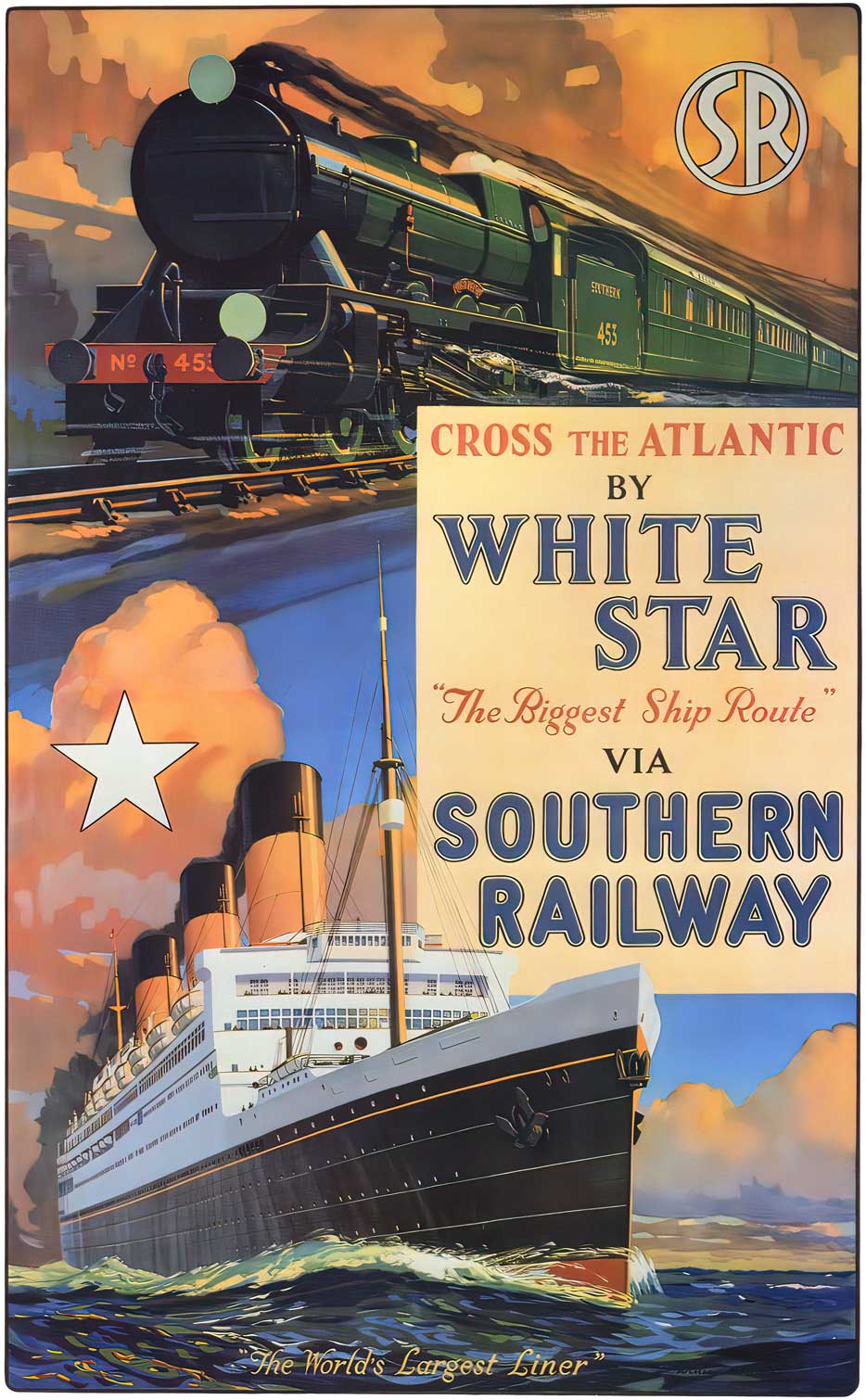
The main departure port for the White Star Line was Southampton, linked to London by Southern Railway (SR). On a 1926 poster the company promoted this connection as 'The Biggest Ship Route', because of the Majestic that was also depicted. Above the ship the boat train is pulled at full speed by locomotive SR 453 'King Arthur'. Designer William McDowell was originally a naval architect, but became a full-time maritime painter and illustrator after WWI, leveraging his knowledge of ship construction.
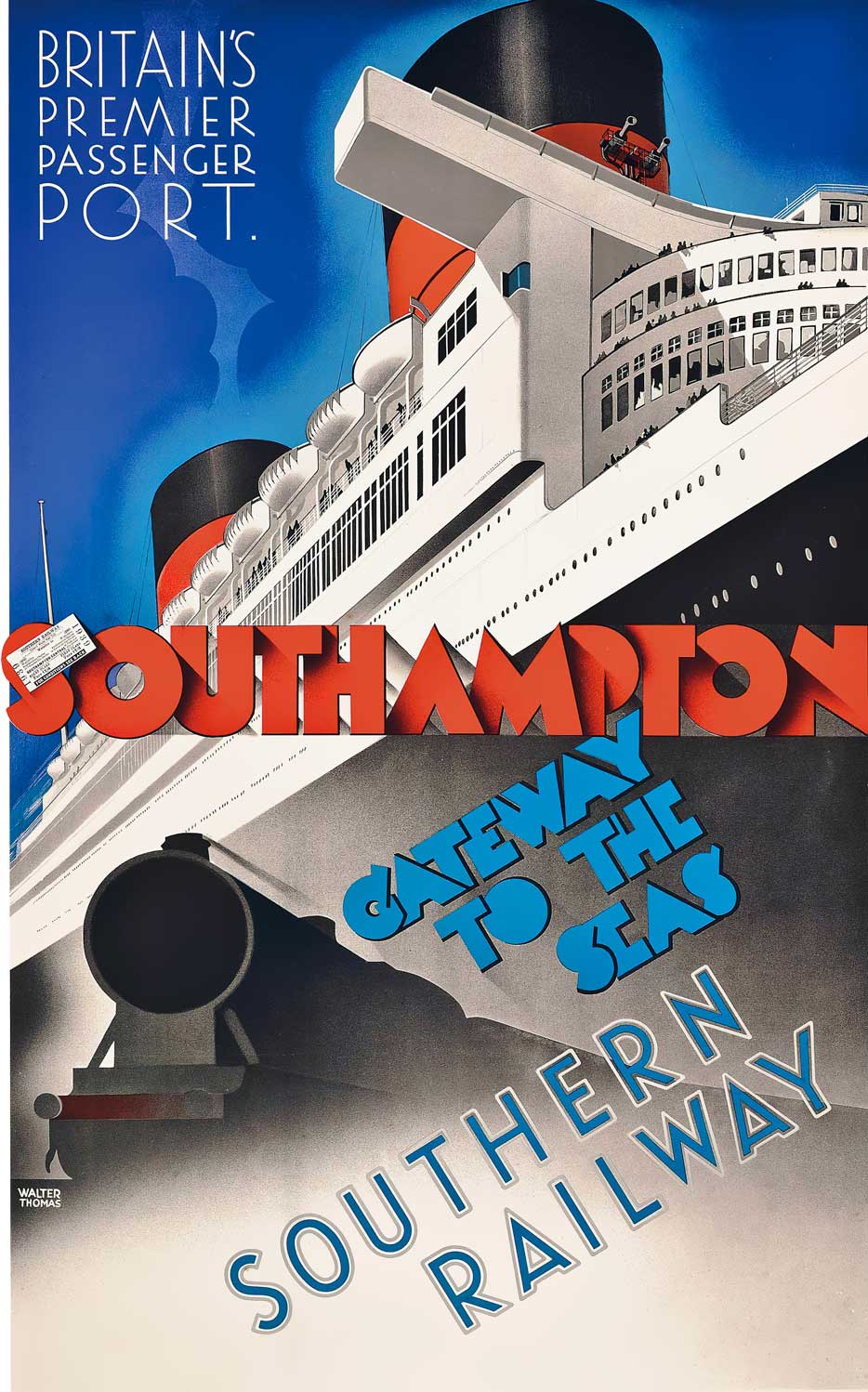
McDowell's colleague Walter Thomas (1894-1971) was also trained as a naval architect, but he attended the Liverpool School of Art as well. He worked for several shipping companies and in 1939 he created a poster for Southampton as the main British port and 'Gateway to the seas'. In addition to an 'anonymous' Southern Railway train, Thomas depicted the RMS Queen Elizabeth, named after the later Queen Mother. Launched by Cunard (into which White Star had merged) in 1938, it would be the world's largest passenger ship for over half a century, with New York as its main destination.
French Line
Ocean liners to North and South America also departed from France. The Compagnie Générale Transatlantique, nicknamed The French Line, had Le Havre in Normandy as its main home port. Marine painter Albert Sebille (1874–1953) created a poster for the Paris-Le Havre-New York connection. The Chemins de fer de l'État boat train is hauled by a class 241 steam locomotive built in 1930. Passengers from Paris are boarding the ship via a canopy bearing the words 'French Line'. Depicted is probably the SS Île-de-France from 1927, fitted with an impressive Art Deco interior to which many French artists had contributed. While before World War I mainly poor migrants were transported, the Cie. Gle. Transatlantique meanwhile catered to affluent passengers with first-class accommodations and French gastronomy.
Despite the name Transatlantique the shipping company also sailed to North Africa, where France had many colonial ties. In 1925 company had even founded the Société des Voyages et Hôtels Nord Africains to promote tourism there. In 1951 Transatlantique brought a new ship into service on the Bordeaux-Casablanca connection. The ship was christened Ville de Marseille, but was soon given a new name to avoid confusion: Maroc. In fact, the connection via Bordeaux offered an alternative to the many ships from Marseille to North Afric. Edouard Collin (1906-1983) created a poster showing the electric boat train arriving from Paris, meanwhile operated by the national railway company SNCF.
The Irish Sea
Important for Great Britain was the connection to Northern Ireland and to Southern Ireland, as the Irish Republic was still called by the English after independence. Many ferry services across the Irish Sea were provided by railway companies. The London, Midland and Scottish Railway (LMS) advertised no less than 'five ways to Ireland', including Holyhead-Kingstown, Liverpool-Dublin and Liverpool-Belfast.
The Great Western Railway (GWR) had started a ferry service from Fishguard in Wales to Rosslare in 1906. At 100 kilometers it was the shortest crossing to southern Ireland. Shortly before the merger into British Railways (BR), GWR commissioned a new vessel in 1947: the turbine steamship St David. It was featured a large horizontal poster issued by British Railways' Western Region in the 1960s.
Marine painter John S. Smith (1921-2010) pictured a boat train at Fishguard Harbour Station with a carriage marked 'Paddington-Cardiff-Swansea-Fishguard Harbour', summarizing the route from London. Directly behind the train the ferry is being loaded while another ship leaves the port. 'Connecting express train services run alongside steamers', states the text in the atmospheric blue area below, as well as that cars can be conveyed too.
A poster from a few years earlier indicated that the ship was 'luxuriously appointed'. The ferry service from Fishguard still exists and Rosslare was given a new Europort Railway Station in 2010. As with all ferries in the Irish Sea, Stena Line is the current shipping company.
The Mediterranean
Marseille was the French port where many ships departed for North Africa as well as the Far East via the Suez Canal. The connection with Paris was provided by railway company Paris-Lyon-Méditerranée (PLM), which cooperated with several shipping lines. De Cie. Gle. Transatlantique also sailed the Mediterranean to a variety of North African destinations, as shown by a poster with five boat trains connecting to four ships that are heading for Oran, Alger and Bône in Algeria and to Bizerte and Tunis in Tunisia. In this period Algeria was a colony of France and Tunisia a French protectorate.
The same destinations are featured on a PLM and Transatlantique poster from 1935 in Art Deco style, designed by Robert Falcucci. Besides railway posters he also created car advertisements for Renault and the Monte Carlo Rally. In addition to Paris and Marseille the route map in red and blue lines shows other cities in France and neighboring countries. In the background dark silhouettes of a ship and a train are crossing the image diagonally, suggesting speed. According to the inscription Marseille received 80 trains a day — although this included all possible directions and train types.
Morocco was also largely occupied by the French. This protectorate was accessible from Marseille by the Compagnie de Navigation Paquet. A poster published by this shipping company and PLM consists of a map of Europe and Morocco. The route between Marseille and Casablanca is shown as a text path with the words 'Traversée la plus courte, la plus rapide, la mieux abritée' (the shortest, fastest and safest journey). The Paris-Marseille railway link is composed of the repeating letters PLM.
Designer Maurice Barbey (1880-?) had participated in the Salon des Indépendants of 1912 as a landscape painter, while in the 1920s he mainly made posters for PLM. His colleague André Hardy (1887-1986) designed a successful poster in 1933 to illustrate the inscription 'transbordement direct du train au paquebot' (direct transfer from train to boat). The two modes of transport are closely entwined by an arrow pointing to the southwest.
Egypt could be reached from Marseille with the Messageries Maritimes, a name that recalled the mail traffic service that had been the origin of the shipping company. The joint poster with PLM reflects the public's fascination with Egyptology following the discovery of Tutankhamun's tomb in 1922. The depicted pharaoh is holding a locomotive in one hand and a ship in the other, exactly at the height of Marseille or Alexandria on the background map. The hieroglyphic cartouches (next to the bottom text box) contain the letters PLM and MM as well as small ships and locomotives. The creator, Joseph Daviel de la Nézière, traveled a lot himself. His visits to North Africa and the Middle East provided him with inspiration for several PLM posters.
Rotterdam Lloyd Rapide
Remarkably enough a boat train to Marseille was also running from the Netherlands. Since the construction of the Suez Canal, mail ships to the Dutch East Indies also called at Marseille or Genoa. In 1927 the Rotterdam Lloyd introduced a special boat train for its passengers: the Lloyd Rapide. By taking the last leg by train, colonial officials and expatriates could enjoy their leave for a week longer. The train traveled in around 20 hours via Paris and Brussels to Rotterdam and The Hague, partly composed of Wagons-Lits sleeping cars. To avoid delays special arrangements were made for customs controls. No transfer was necessary and the train ran directly onto the quay.
At the start of the Lloyd Rapide Machiel Wilmink created a poster that emphasized speed, as the name of the train did. The rendering of the rushing steam locomotive suggests movement by means of lines coming together. It looks like Wilmink found inspiration from the futurism of a decade before. Artists of this movement were using cubist forms to glorify speed, energy, aggression and progress. A second Lloyd Rapide poster consists of an ingenious schedule with departure times of connecting (Dutch) trains, in a fan shape reminiscent of a peacock's tail.
Norddeutscher Lloyd
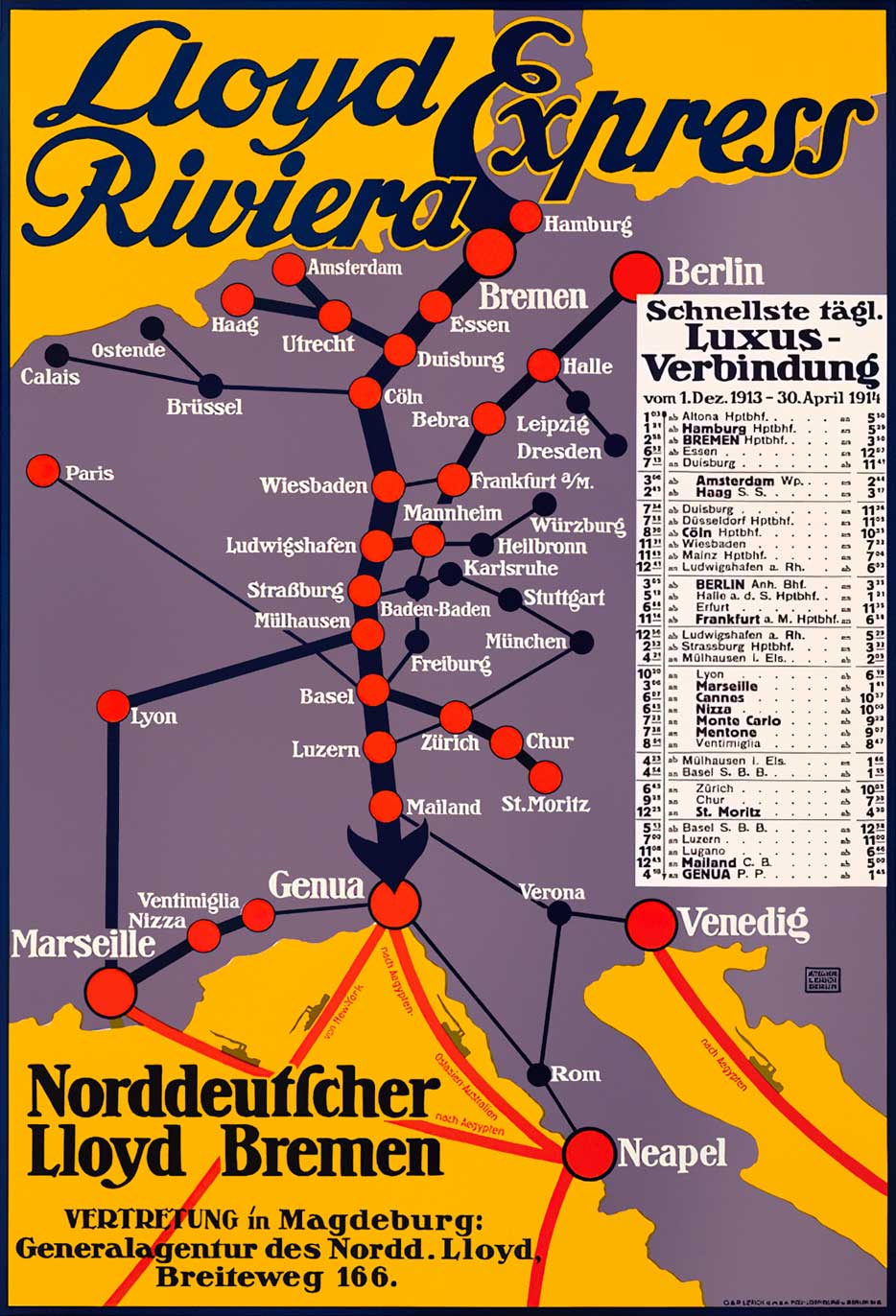
Boat trains also departed from Germany to the ports on the Mediterranean. By boarding there instead of Hamburg or Bremen, passengers could save a lot of travel time. Since 1908 the Lloyd Express had been running from Hamburg and Berlin to Genoa, where ships of the Norddeutscher Lloyd departed for the Americas and Egypt and to East Asia and Australia via the Suez Canal. From 1911 the Lloyd Express also had a Dutch branch, which ran combined with carriages of the Riviera Express. The German poster published for the LLoyd-Riviera Express in 1914 was remarkably modern with its schematic route map.

The Norddeutscher Lloyd also offered round trips and cruises from Genoa. Under the motto 'Mare Terra' (sea and land) people could enjoy 'the most complete cruise from Italy to Germany' in 1939. The outward or return journey was by rail. On the poster, ship and train are running side by side against the backdrop of a map of Europe. The Second World War soon put an end to these cruises.
Strait of Messina
In addition to boat trains that connected to the major transcontinental lines in Genoa and Trieste, Italy had a real train ferry over a short distance since 1899. Two 'ferry-boats' bridged the Strait of Messina between Sicily and the Italian mainland, a distance of little more than 7 kilometers. The decks of the ferries Scilla and Cariddi were fitted with rails for a locomotive with five carriages or wagons to run on.
In collaboration with Wagons-Lits the Strade ferrate della Sicilia operated a direct luxury train between Naples and Palermo, with through cars from Rome, Paris and Berlin. Nowadays the FS train ferry across the Strait of Messina is the only one still used for passenger traffic in Western Europe.
The Baltic
In Denmark, a country of islands and peninsulas, the railways had always depended on ships for through routes, for example between Jutland and Funen. For the connection with Germany, a train ferry was put into operation in 1903, linking Gedser with Warnemünde on the German Baltic seacoast. A poster from 1907 shows the direct train from Berlin to Copenhagen on the wooden deck of one of the two ferries, which where named Prinsessin Alexandrine and Friedrich Franz IV.
A later poster for the Danske Statsbaner (DSB) by Sven Henriksen (1890-1935) shows a ship and a train at full speed. A small map with red lines does not distinguish between land and sea routes. In 1935 Henriksen would design a new poster for the Little Belt Bridge linking Jutland and Funen, which made one of the domestic ferry connections superfluous.
When after the Second World War Warnemünde became part of the socialist GDR, the Deutsche Bundesbahn (DB) started its own rail ferry to Gedser from Grossenbrode in West Germany. It was a temporary solution between 1951 and 1963. On one of his many DSB posters designer Aage Rasmussen (1913-1975) showed how the front bow of the rail ferry opened to let the train in.
A German poster in a naive style made clear that in addition to trains, cars were also shipped. It was created by Erika Müller (1930-2010), one of the few women who designed posters for the Deutsche Bundesbahn.
In 1963 the Vogelfluglinie (bird flight line) was opened as a faster connection between West Germany and Denmark. It consisted of the 963 meter long Fehmarnsund Bridge and a shorter train ferry between Puttgarden and Rødby. The ferries Deutschland and Theodor Heuss from the Grossenbrode-Gedser connection now operated on this line. Posters for the Vogelfluglinie often showed flying seabirds looking down on the ferry route, but a variant with swans is also known. The train ferry Puttgarden-Rødby would be decommissioned in 2019 due to the construction of the Fehmarn Belt Link. This puts an end to the decades-long application of railway ferries in Denmark.
Sassnitz-Trelleborg
In 1909 the Swedish King Gustav V and German Emperor Wilhelm II (in his capacity as King of Prussia) inaugurated the rail ferry between Sassnitz in Germany and the Swedish port of Trelleborg. That is why the connection was called Königslinie or Kungslinjen (King's Line). This railway ferry across the Baltic was the longest in Europe at a distance of 100 kilometers — a crossing of about four hours. The two German ferries were called Preußen and Deutschland and the Swedish ones were named Konung Gustav V an Drottning Victoria. The four ships each had a deck with two tracks, adding up to 165 meters of rails. They could accommodate 18 carriages and a maximum of 975 passengers. A poster from 1933 visually calls this connection Ostseebrücke (Baltic Bridge). The rail ferry ran twice a day in both directions with direct trains between Berlin and Stockholm.
After the Second World War Sassnitz became part of the GDR. Despite travel restrictions, Deutsche Reichsbahn (DR) and the Swedish Railways came to an agreement to revive the ferry service. In 1958-59 new ships with four tracks and a separate car deck were put into service. They were given the predictable names of Trelleborg and Sassnitz. In 1972 the GDR ship Rügen followed, with two car decks and four tracks at a combined length of 480 meters. The 'Berlinaren', a fast diesel-electric train of the prestigious DR VT 18.16 series, ran during daytime and the Saßnitz-Expreß with sleeping cars at night. The ferry trains were mainly used by Scandinavians, West Berliners and diplomats. A Deutsche Reichsbahn poster for the Rügen shows a silhouette of the 17th-century Swedish warship Vasa, which was salvaged in 1961.
